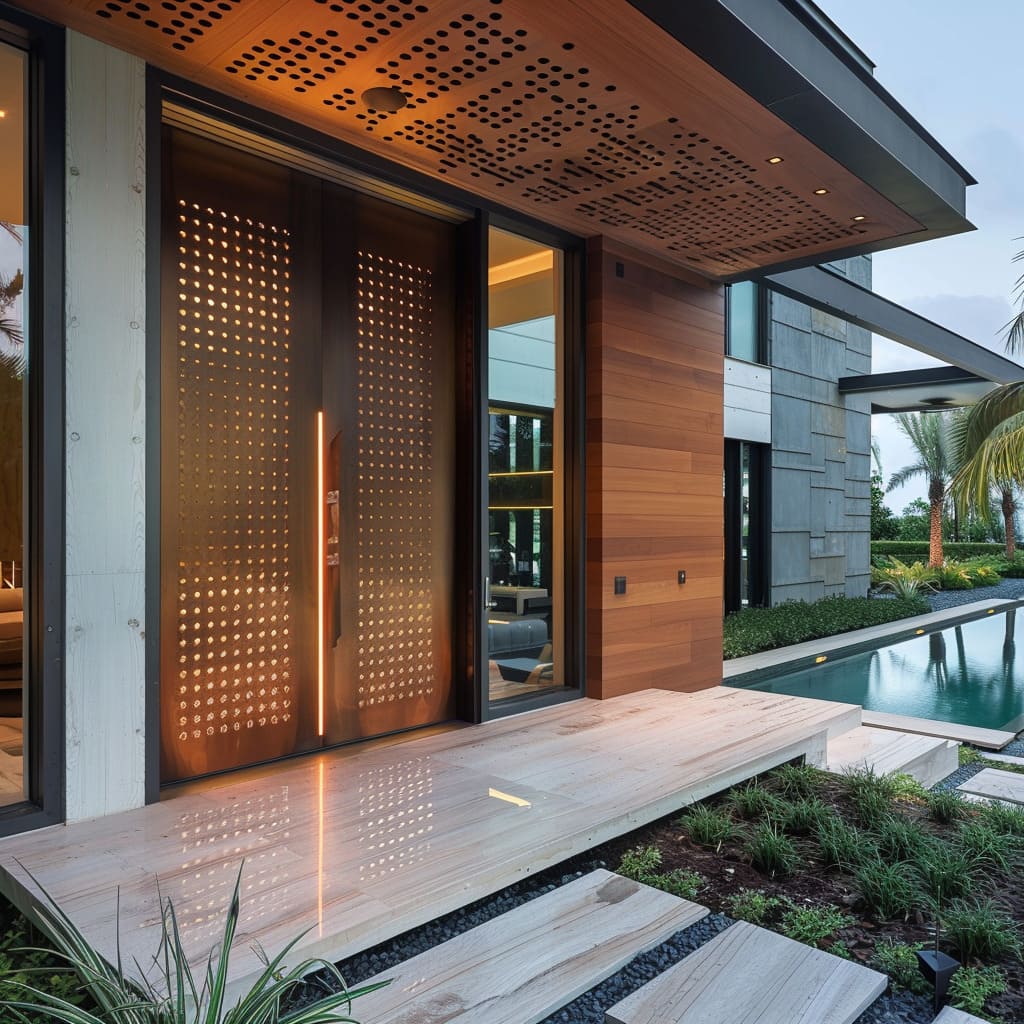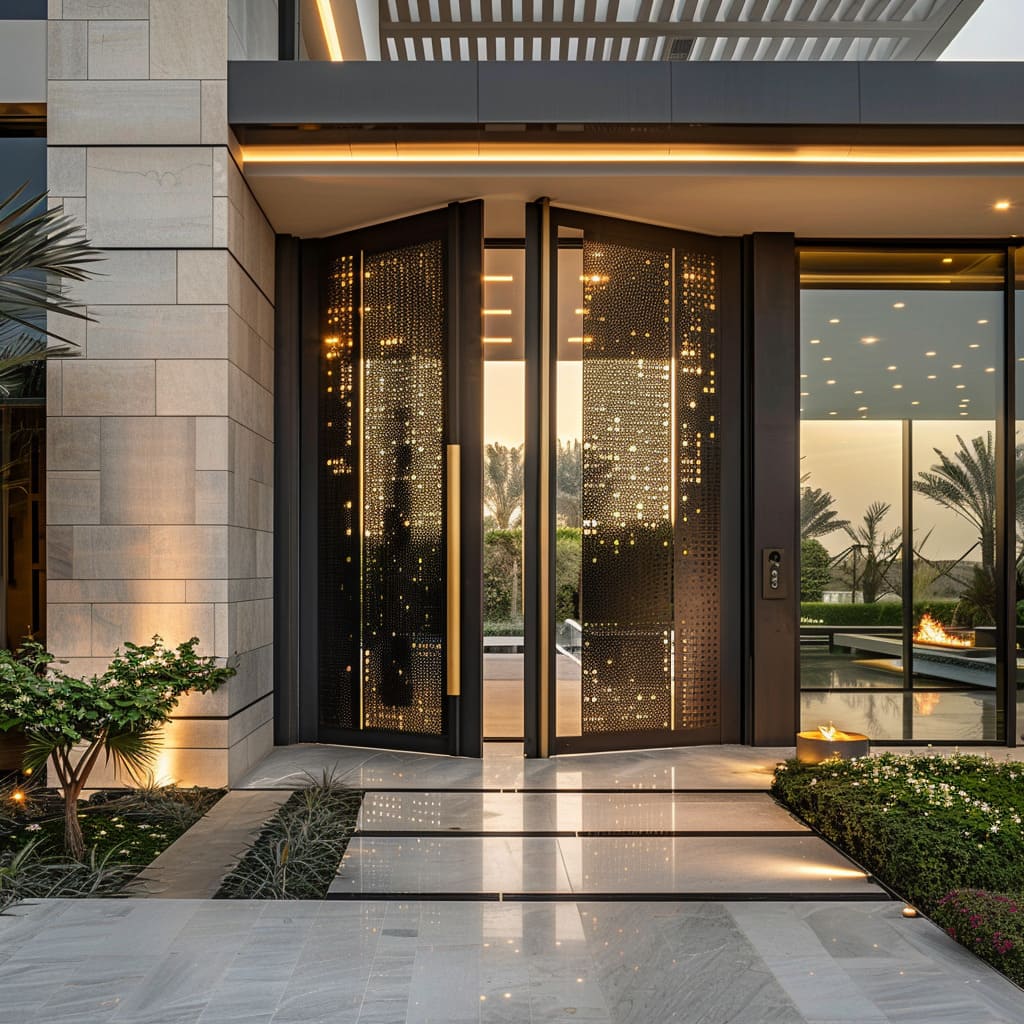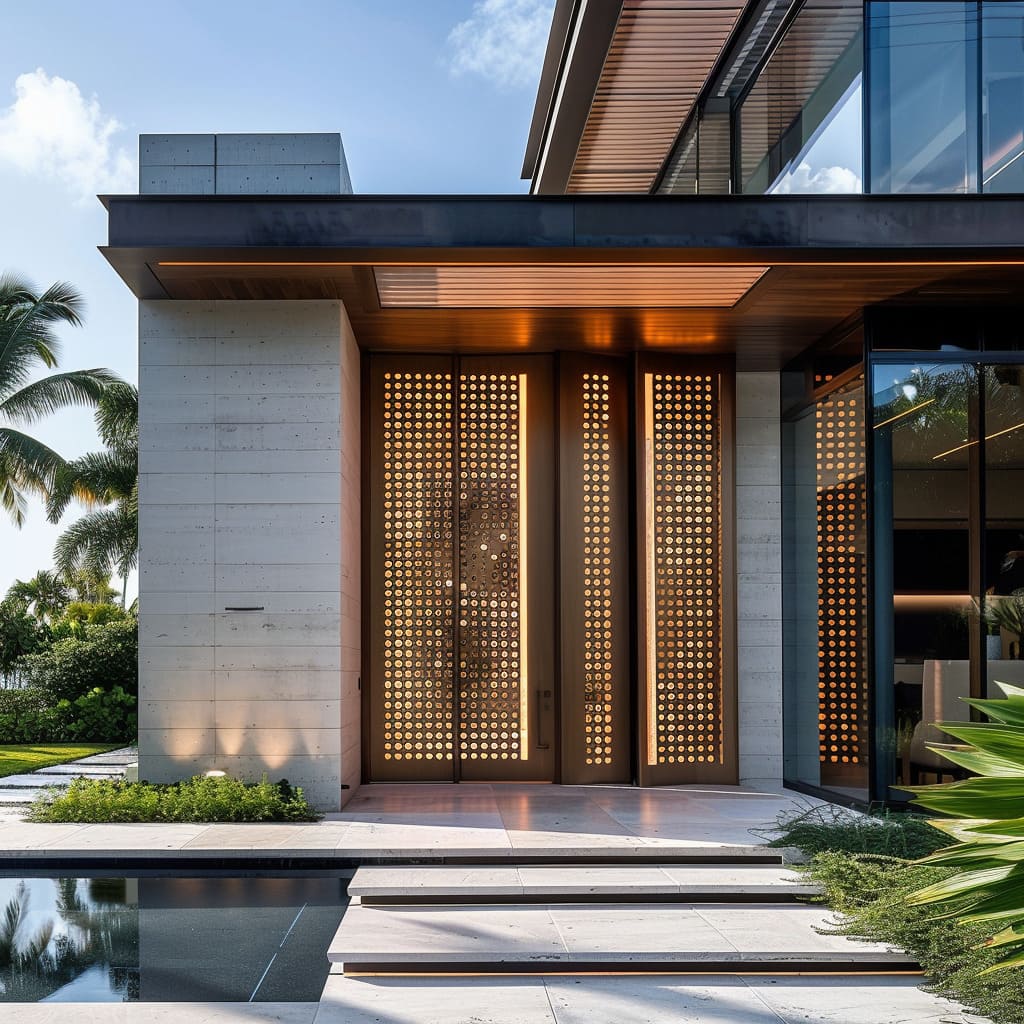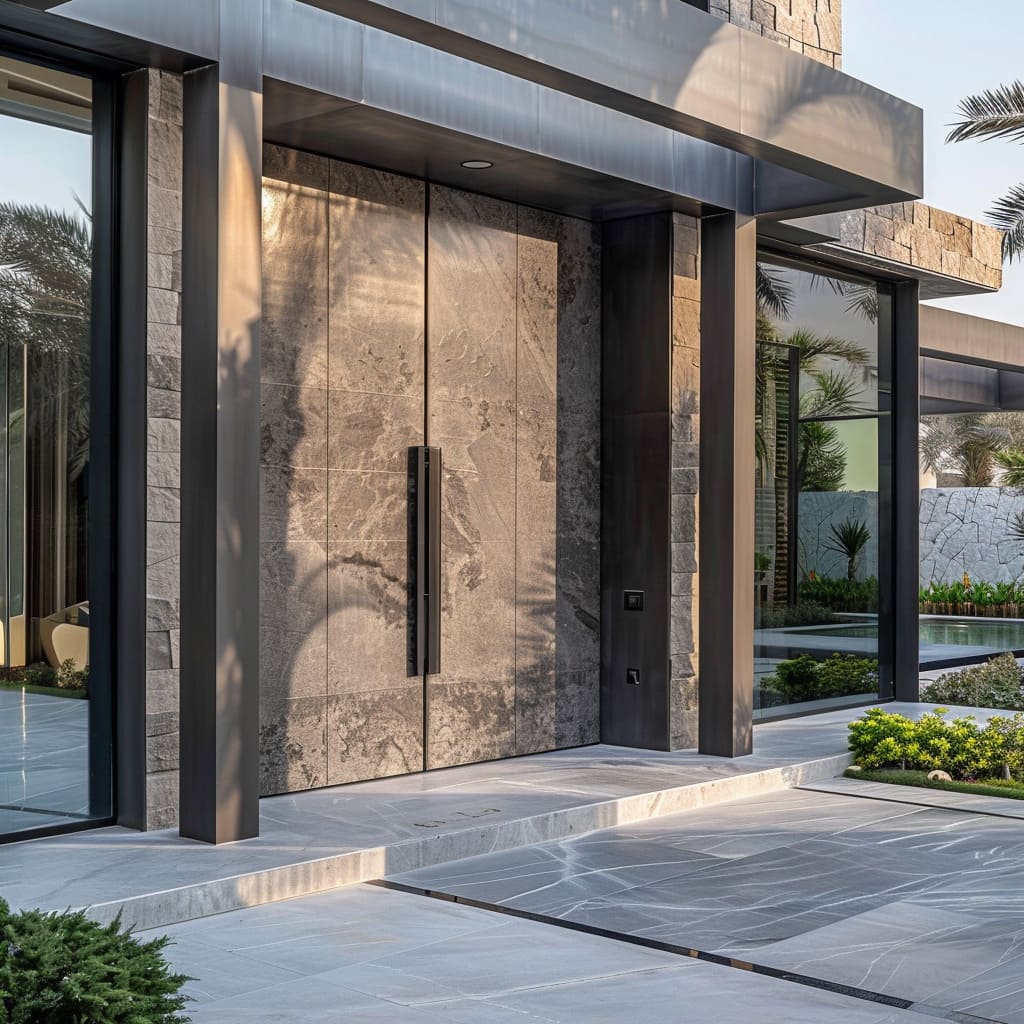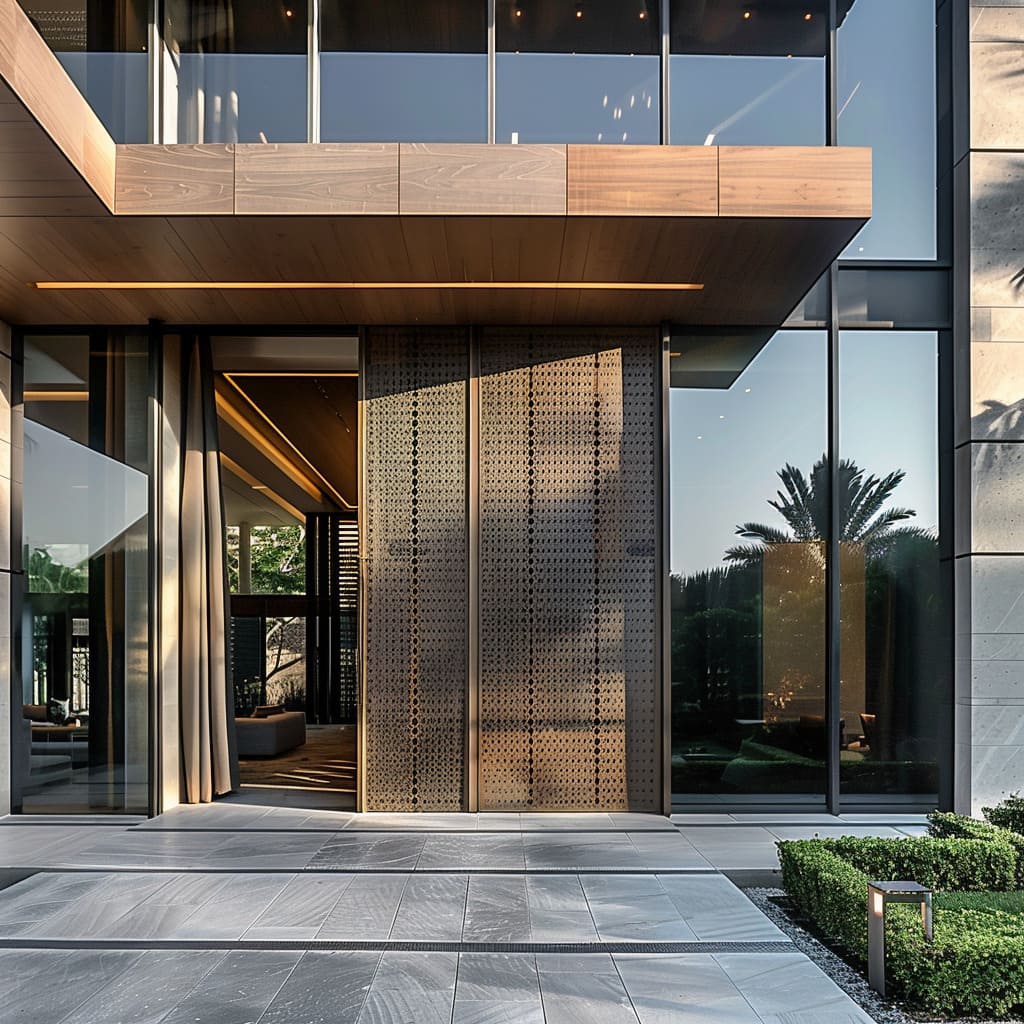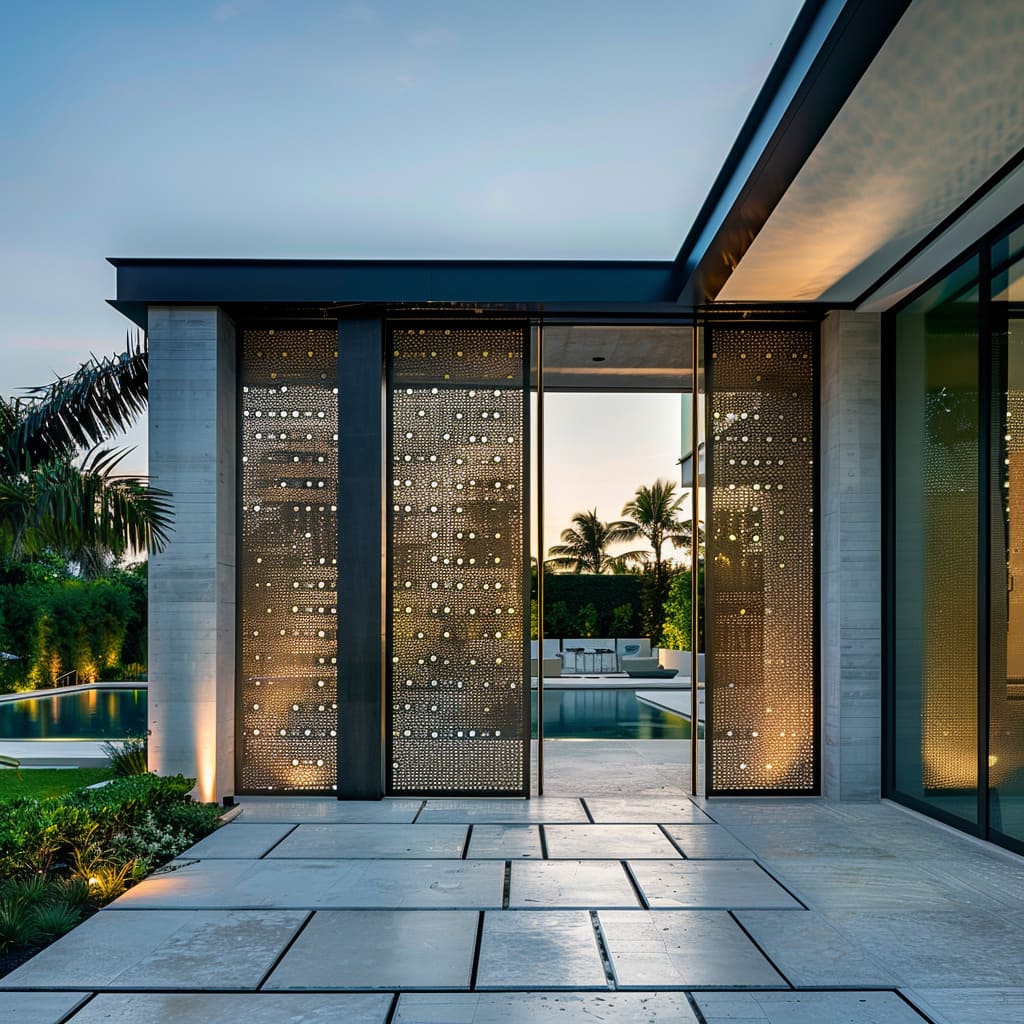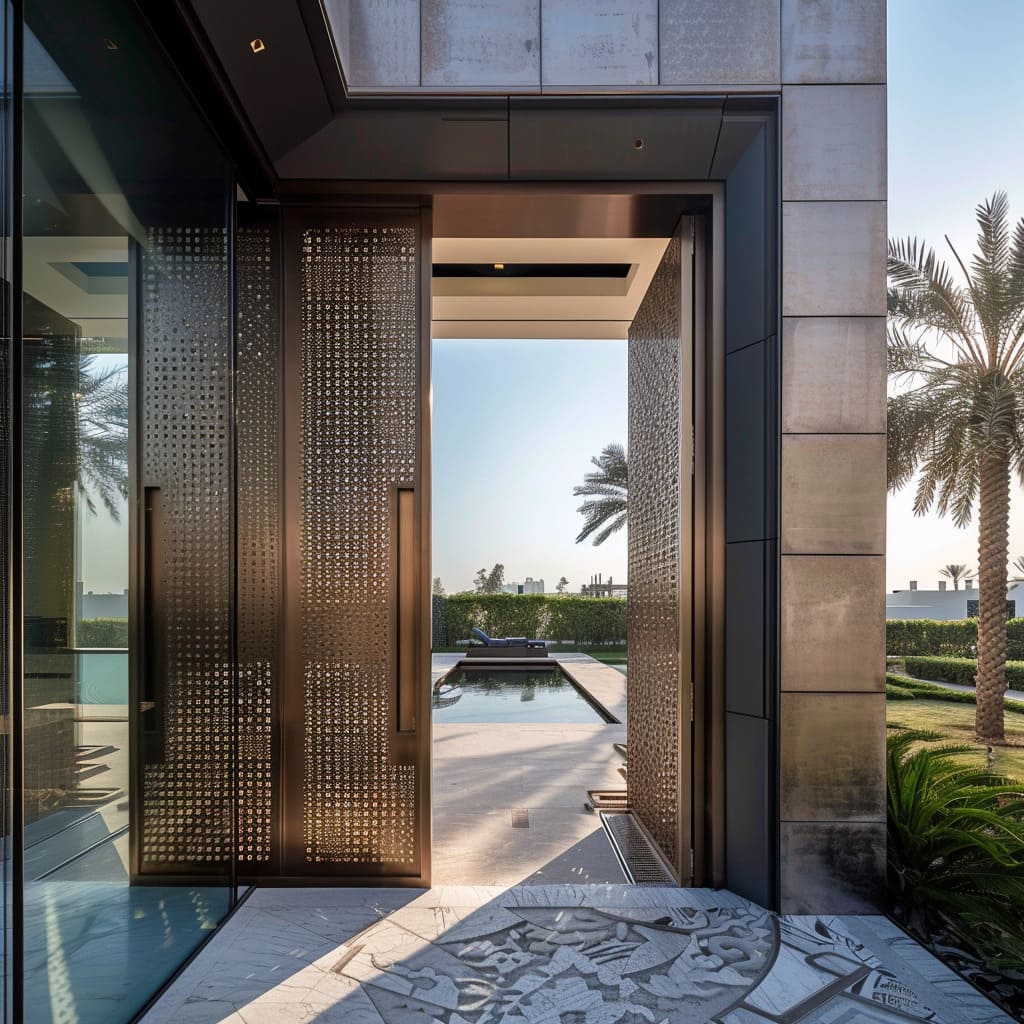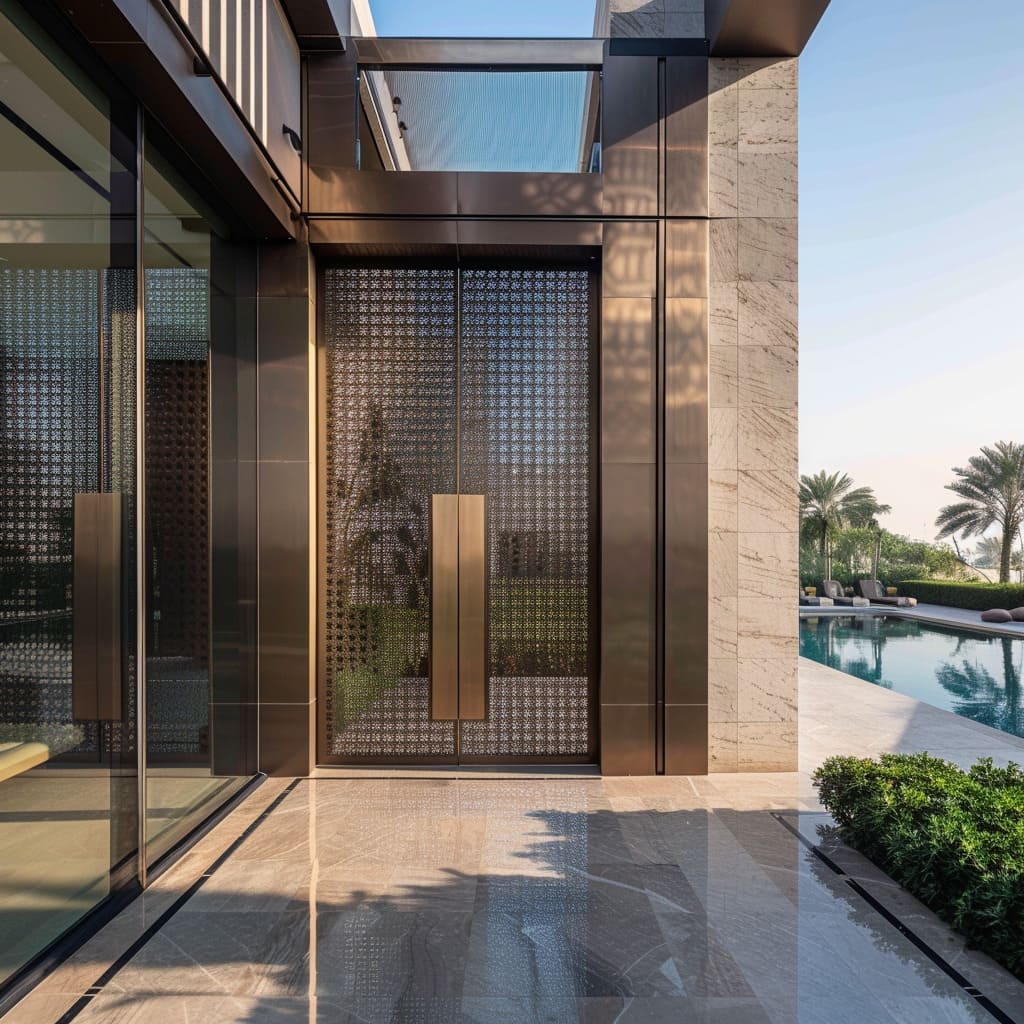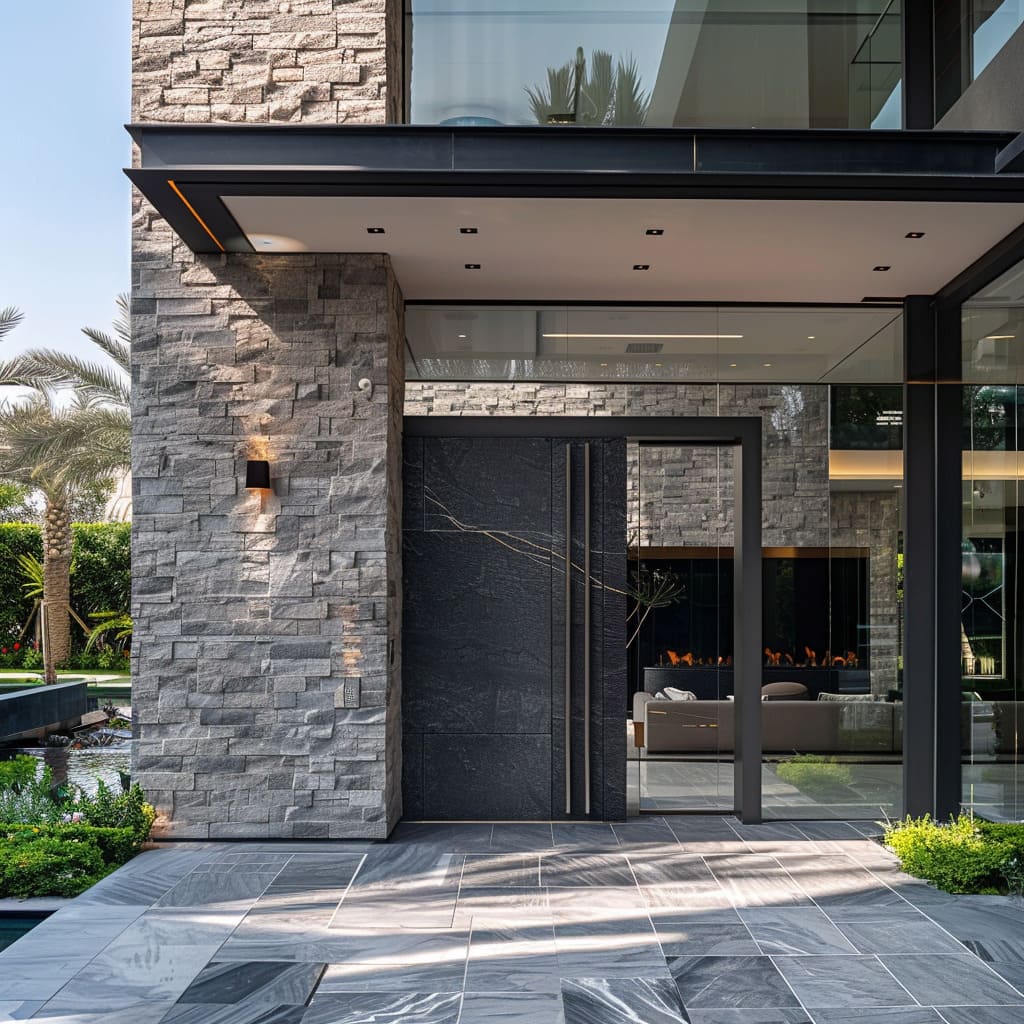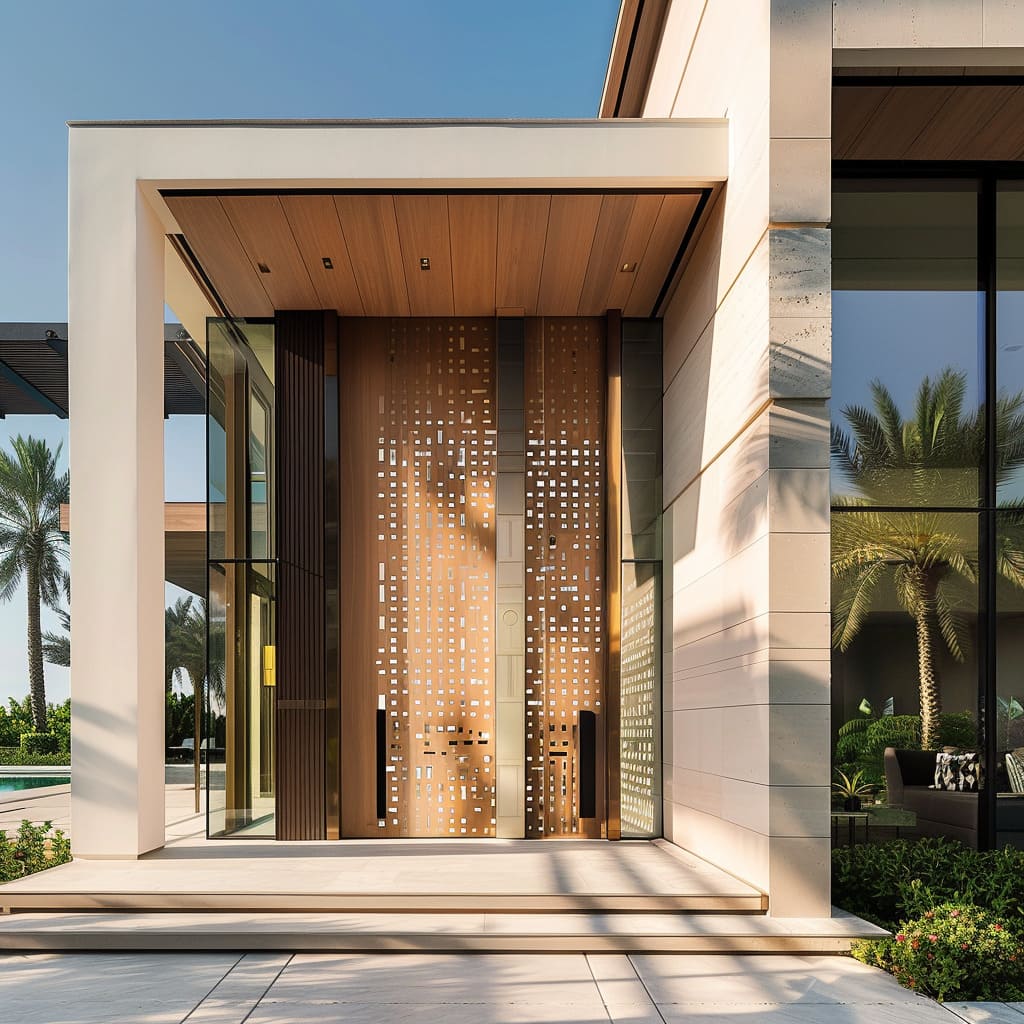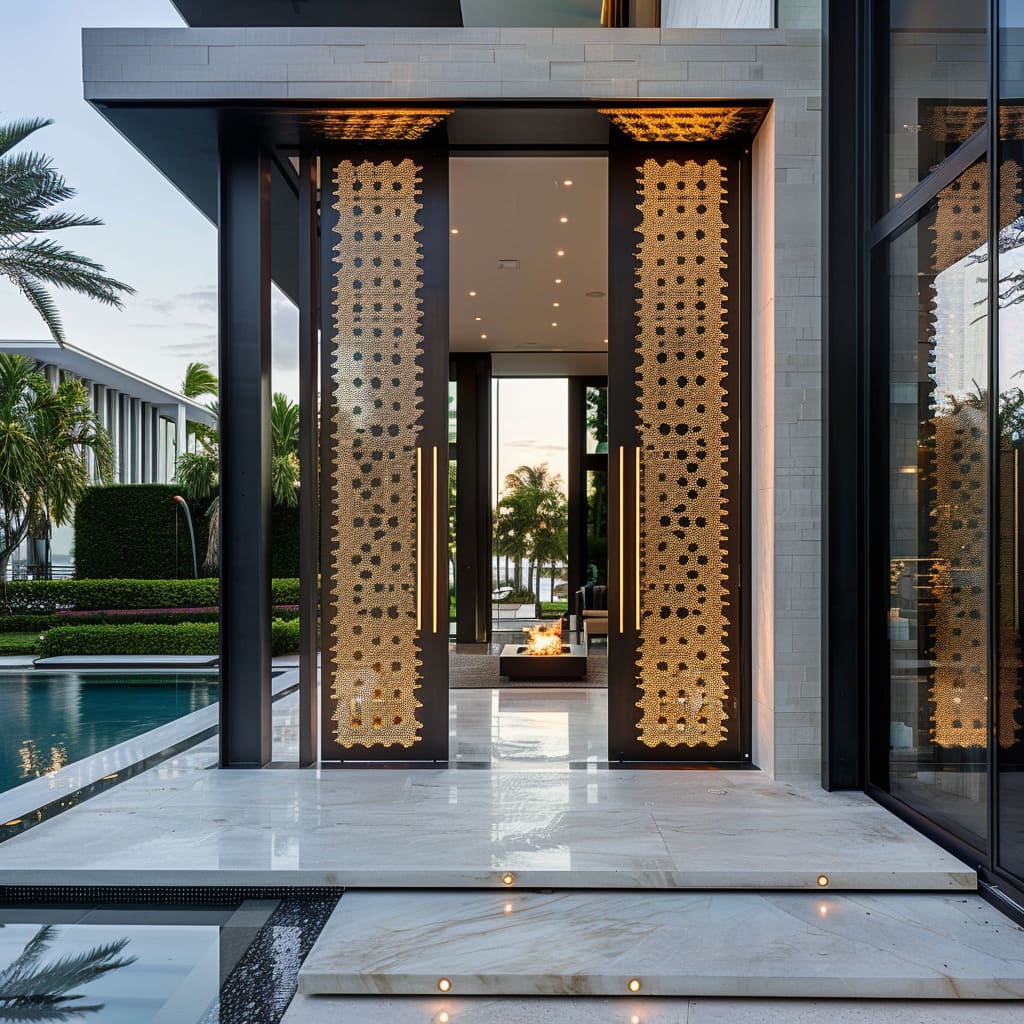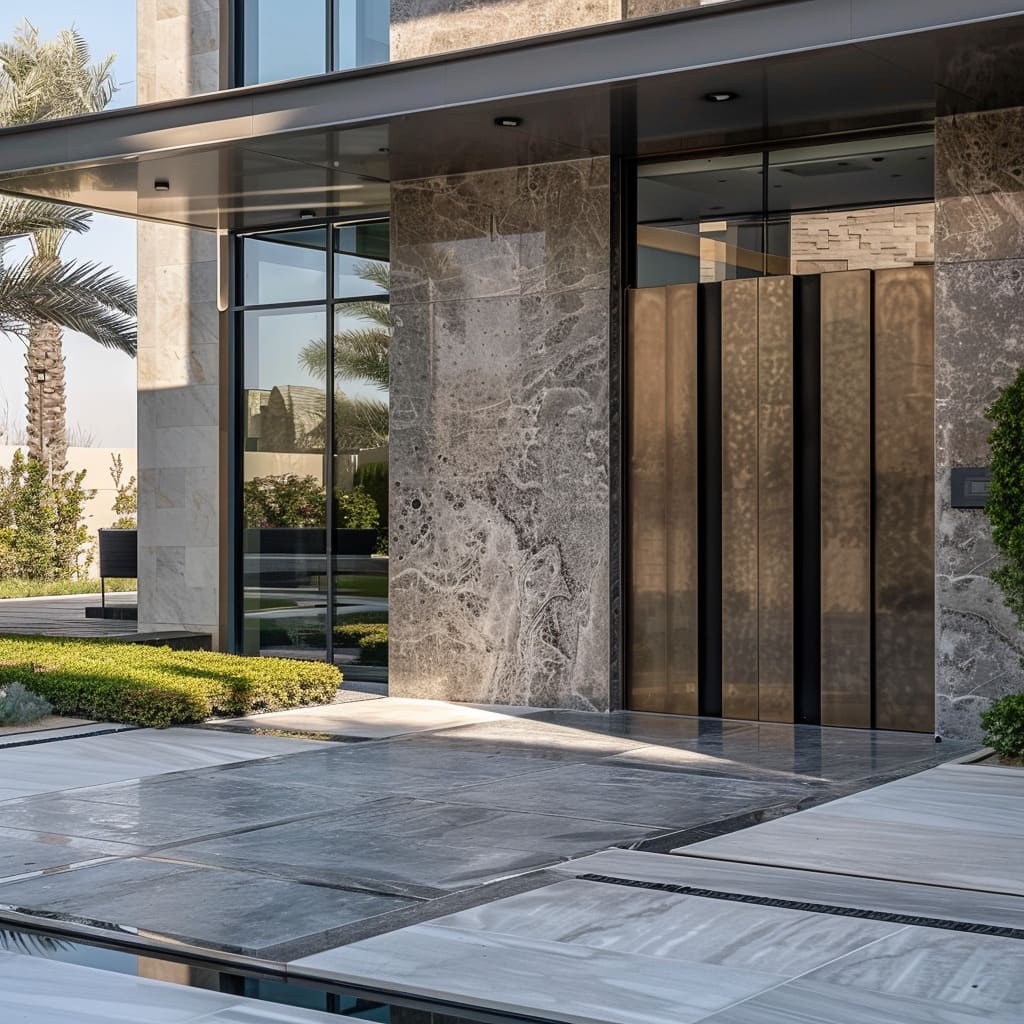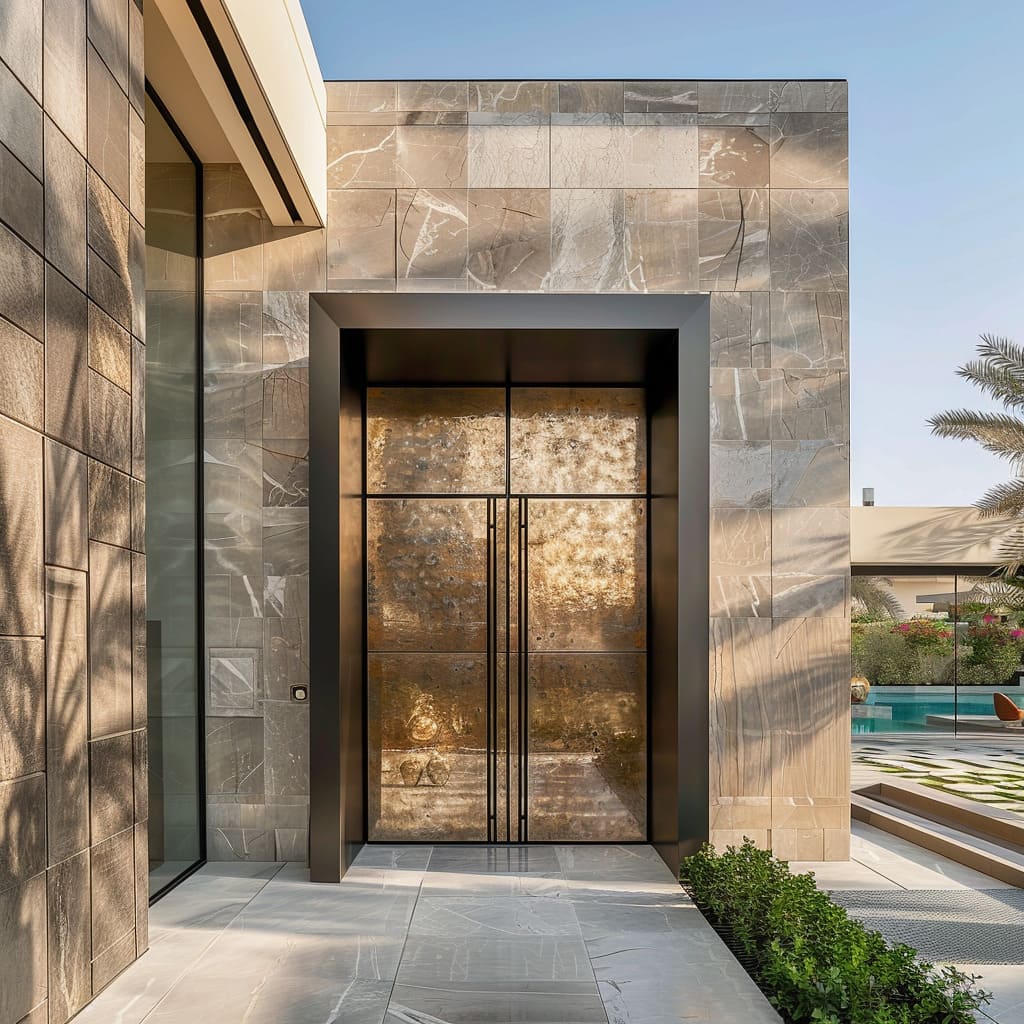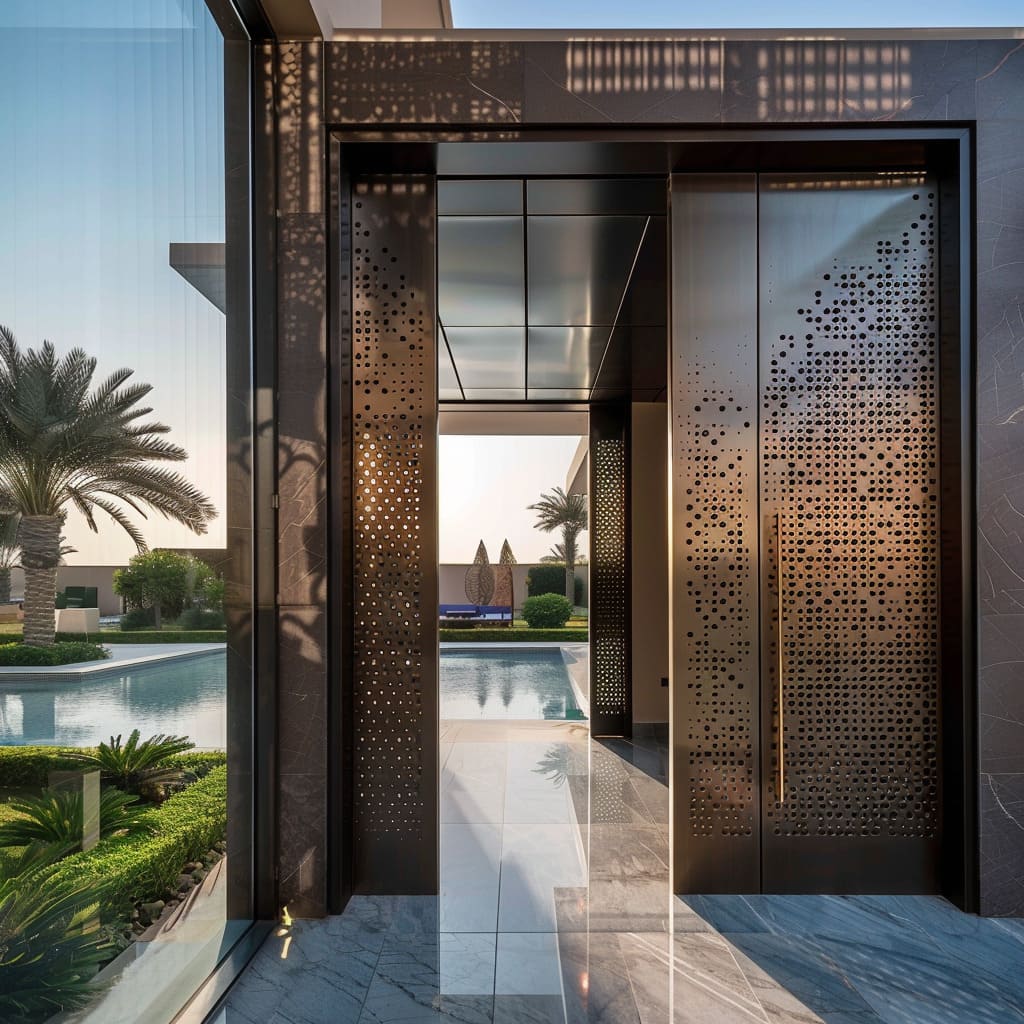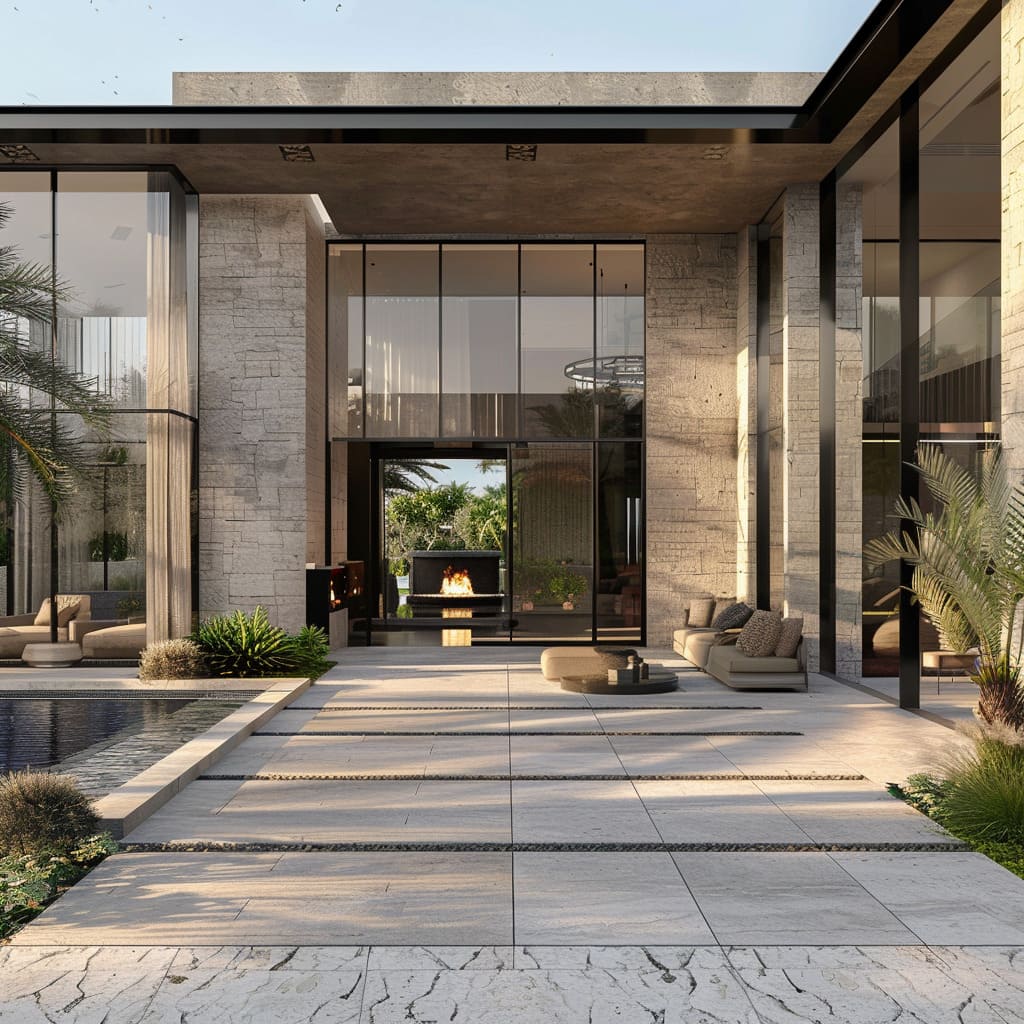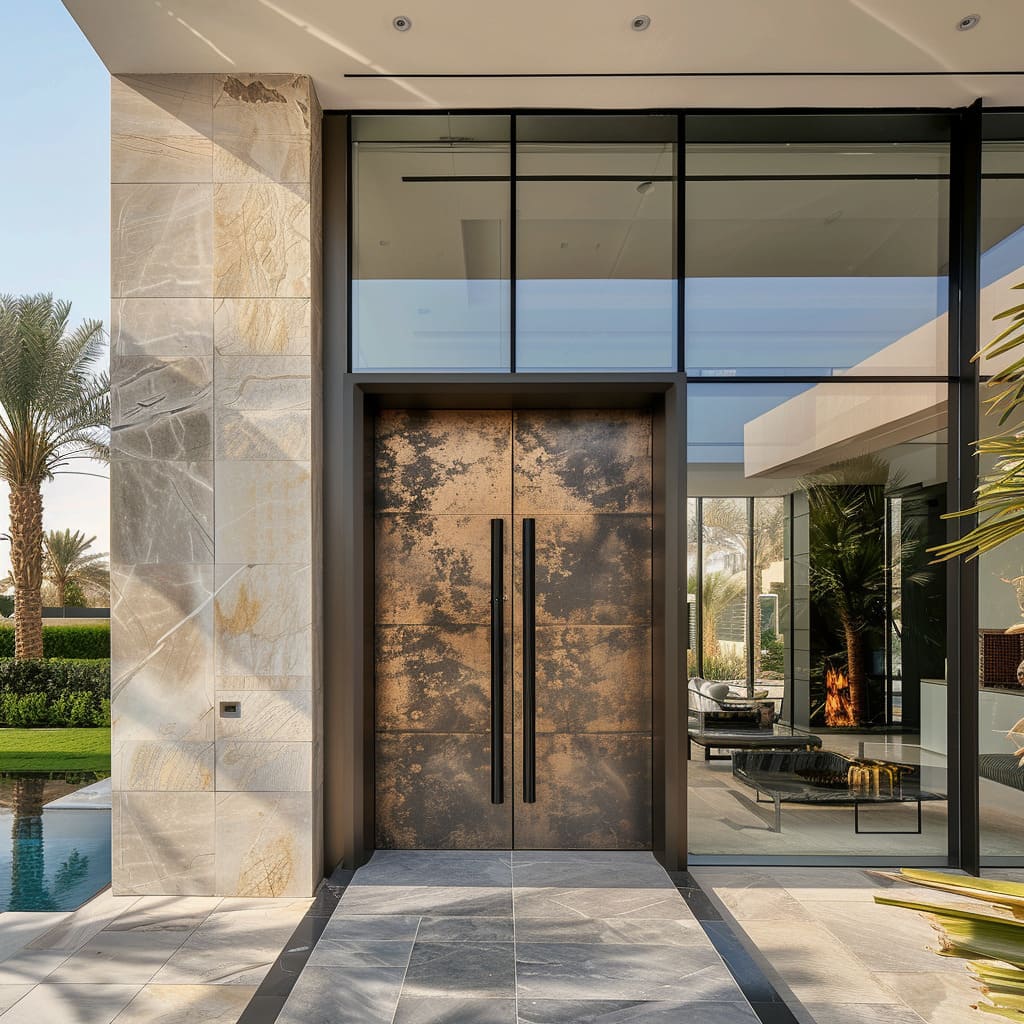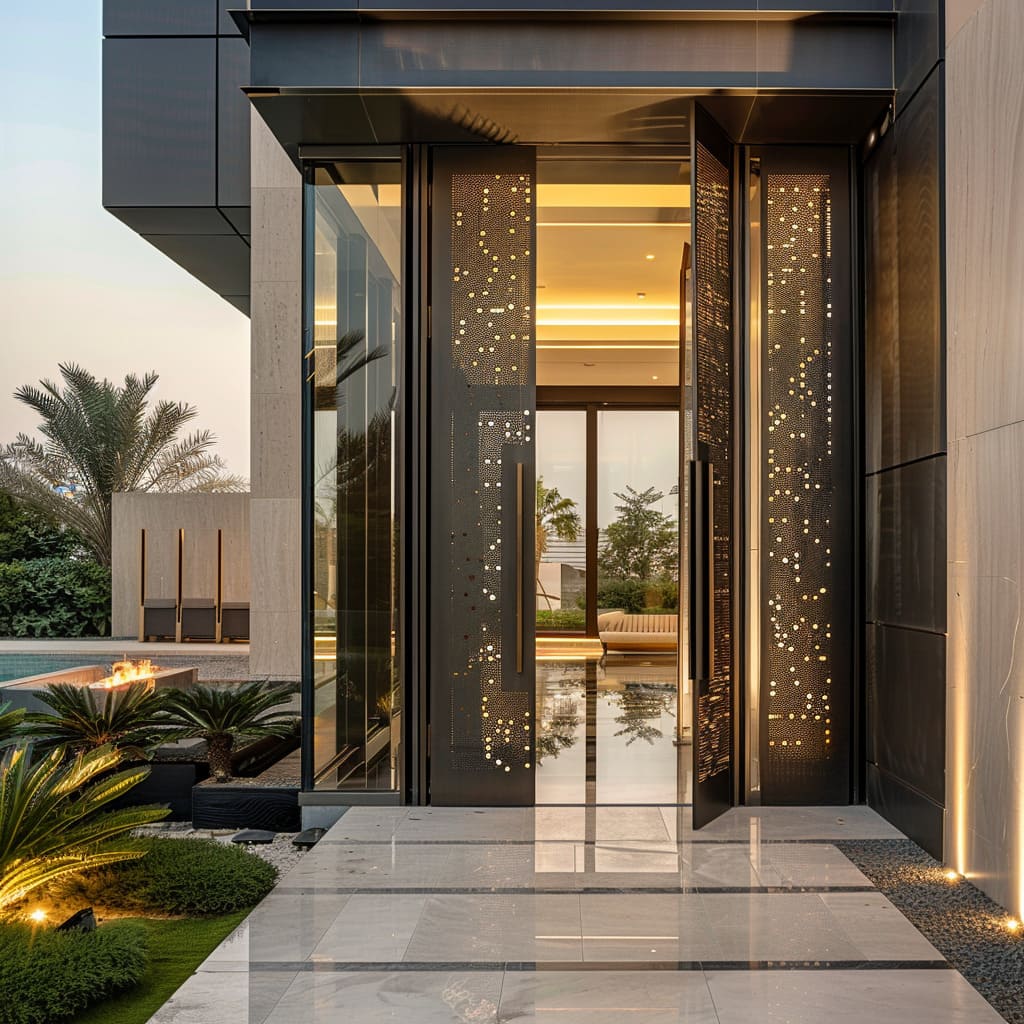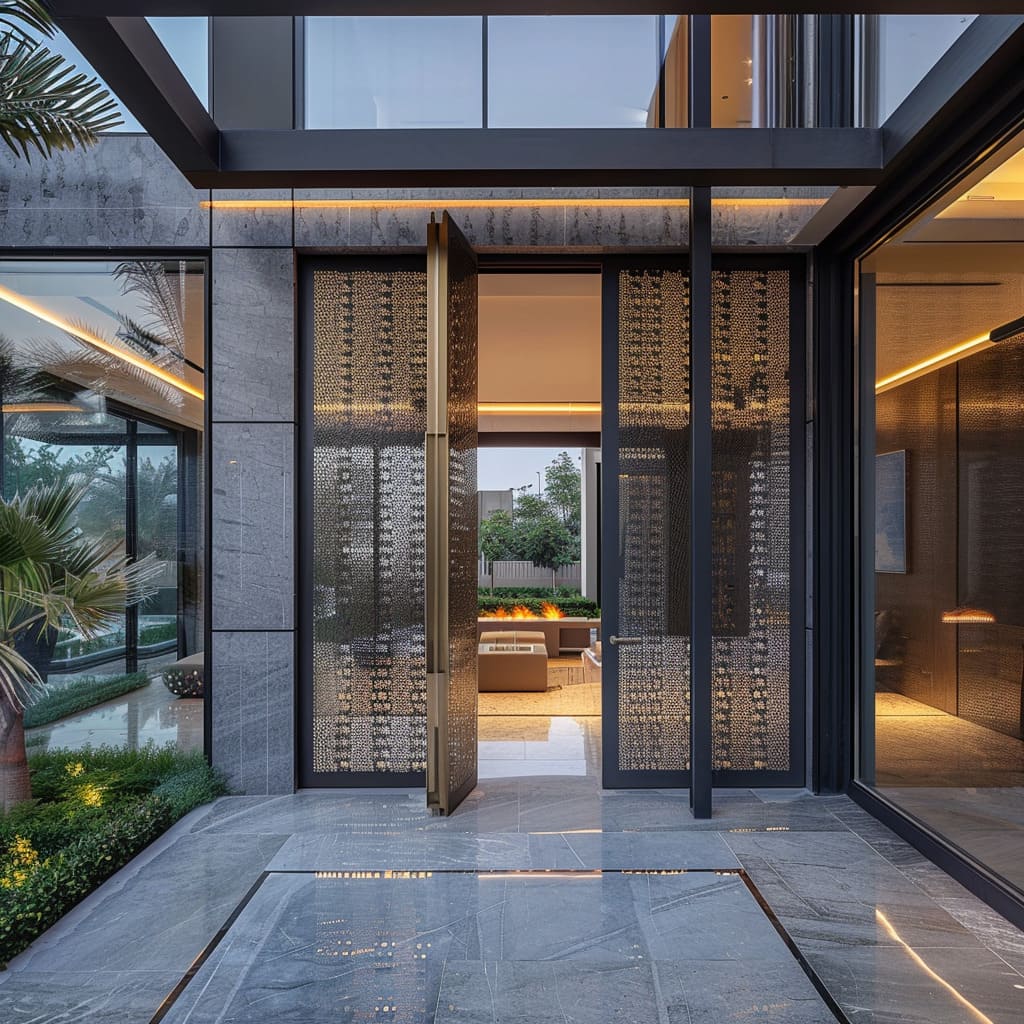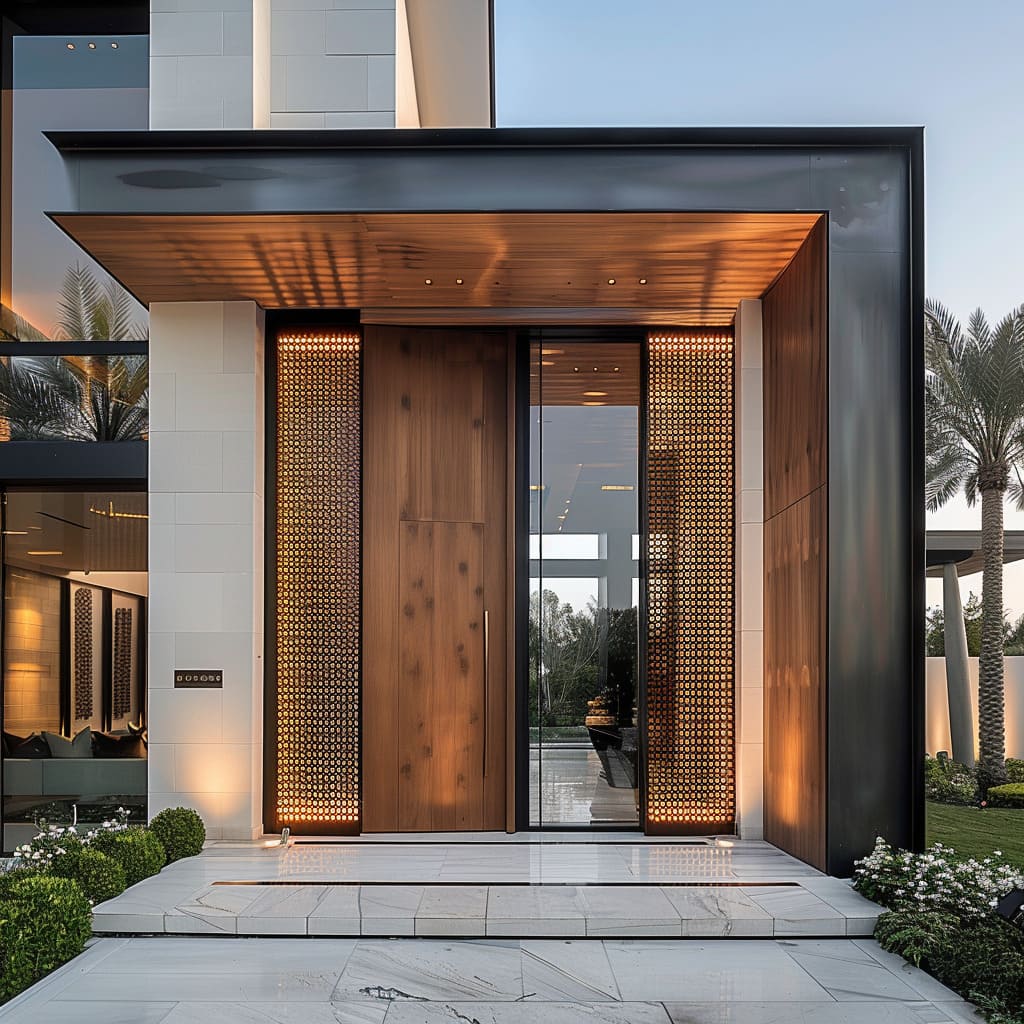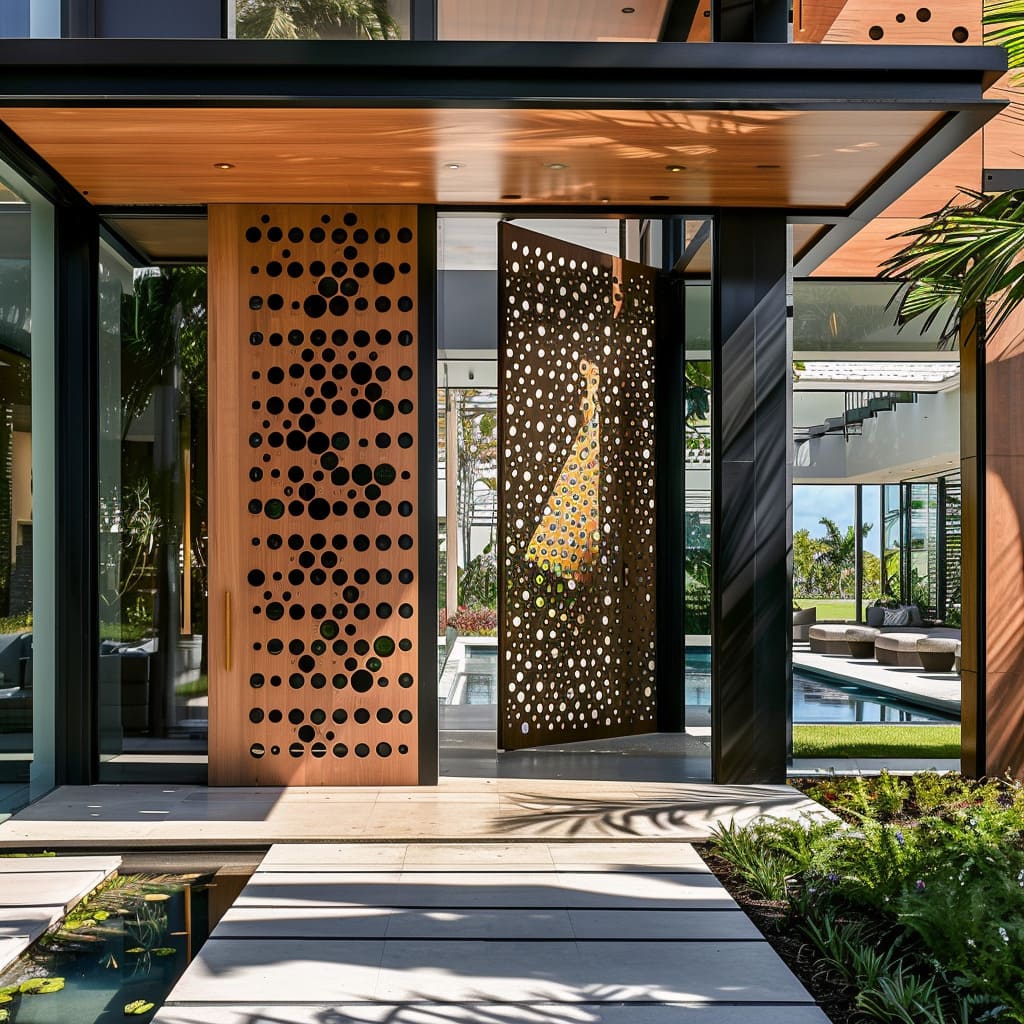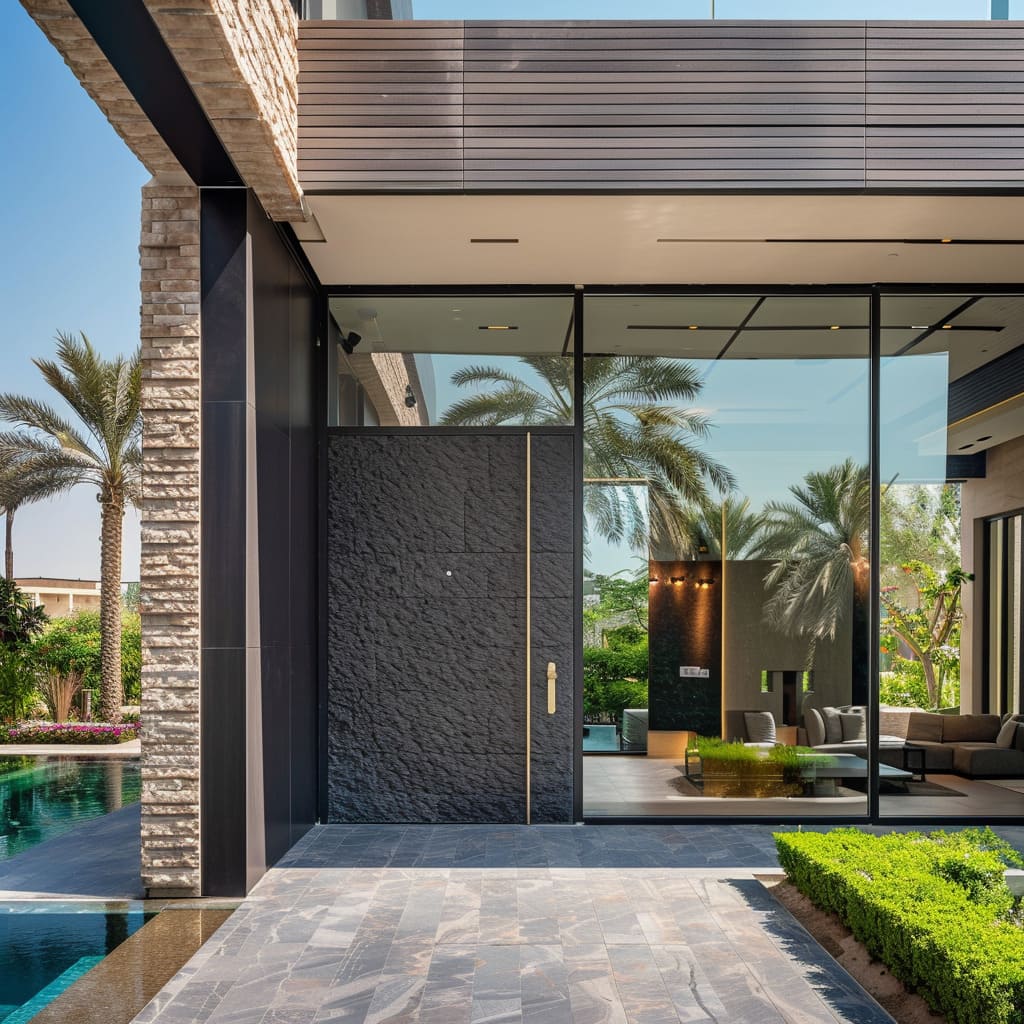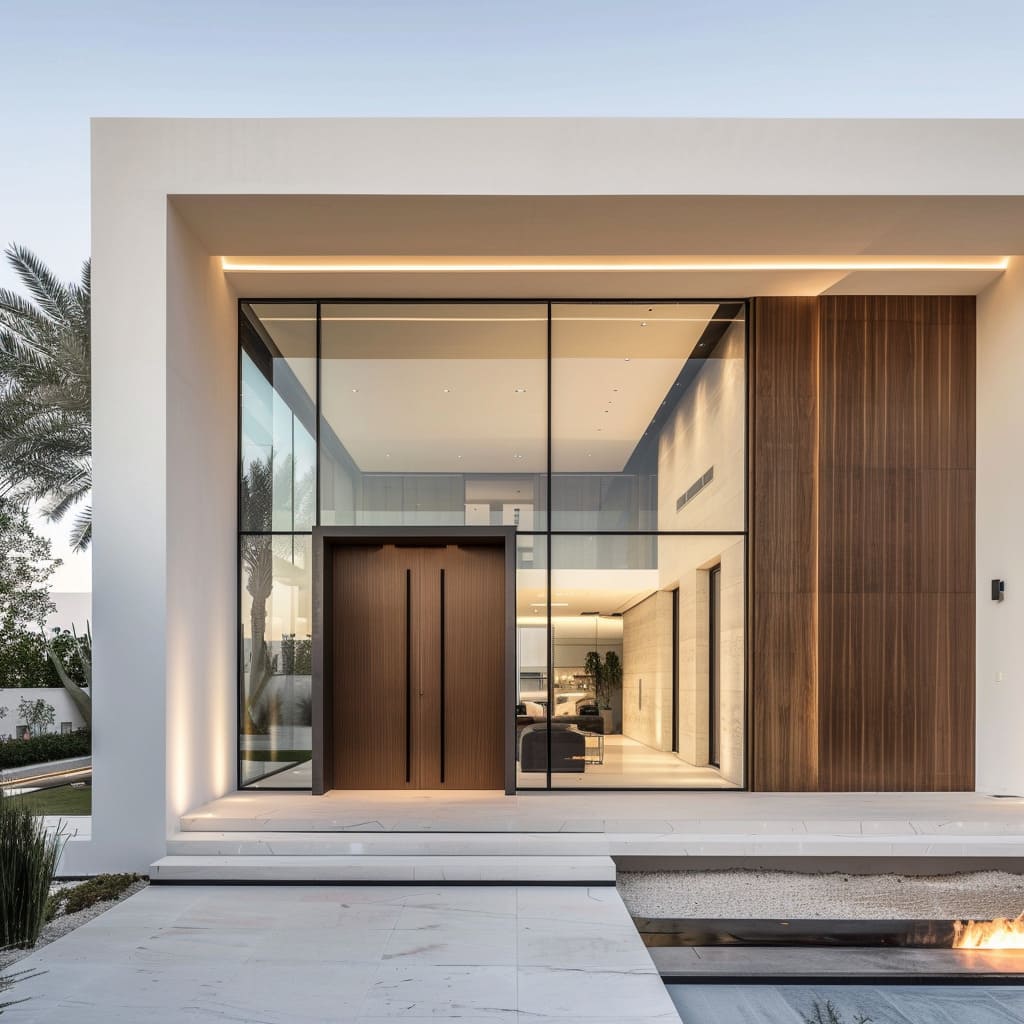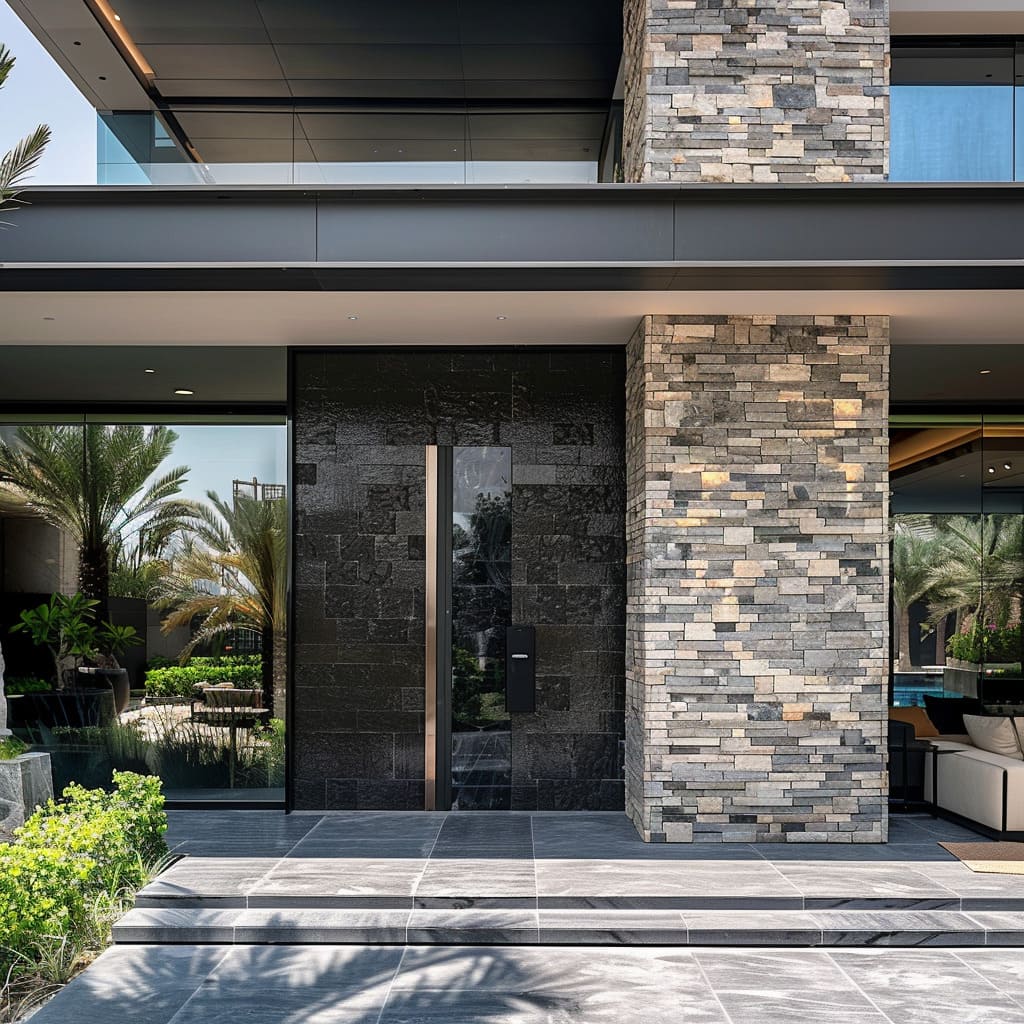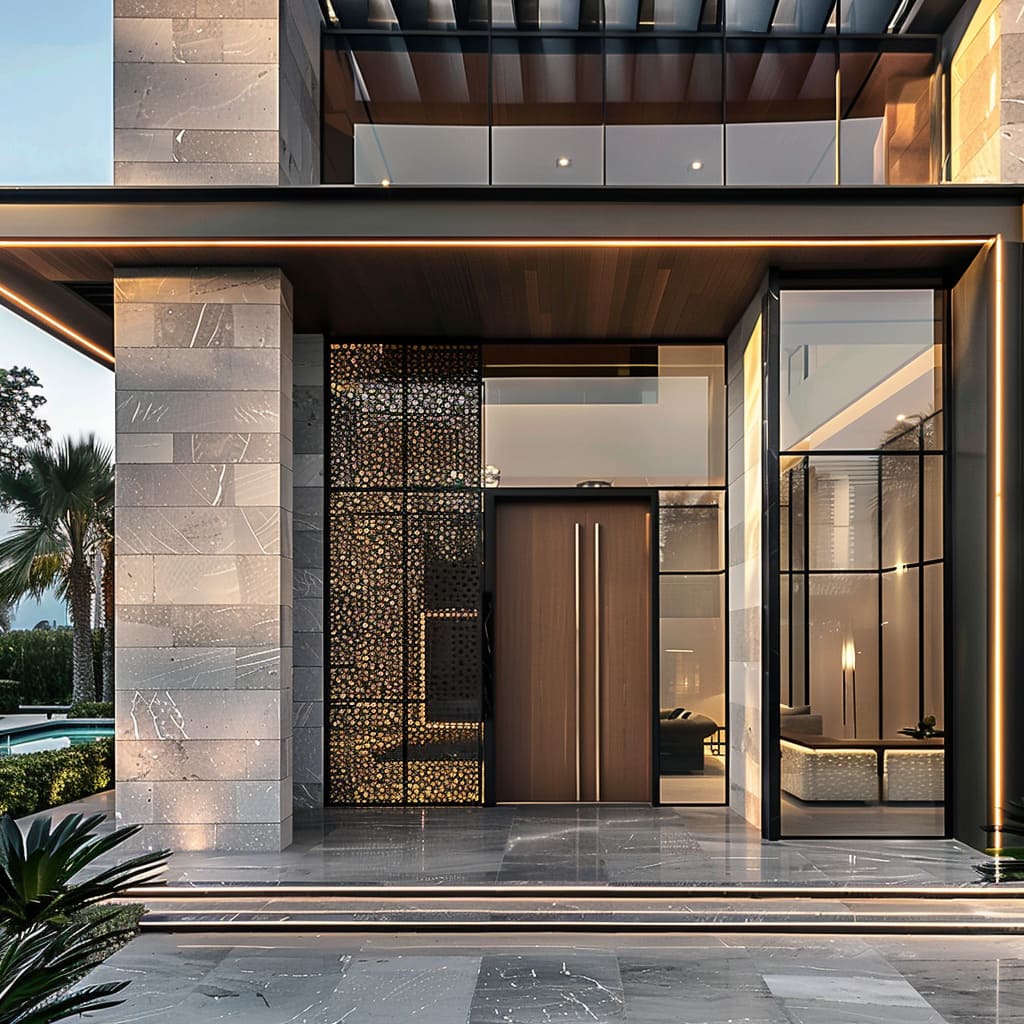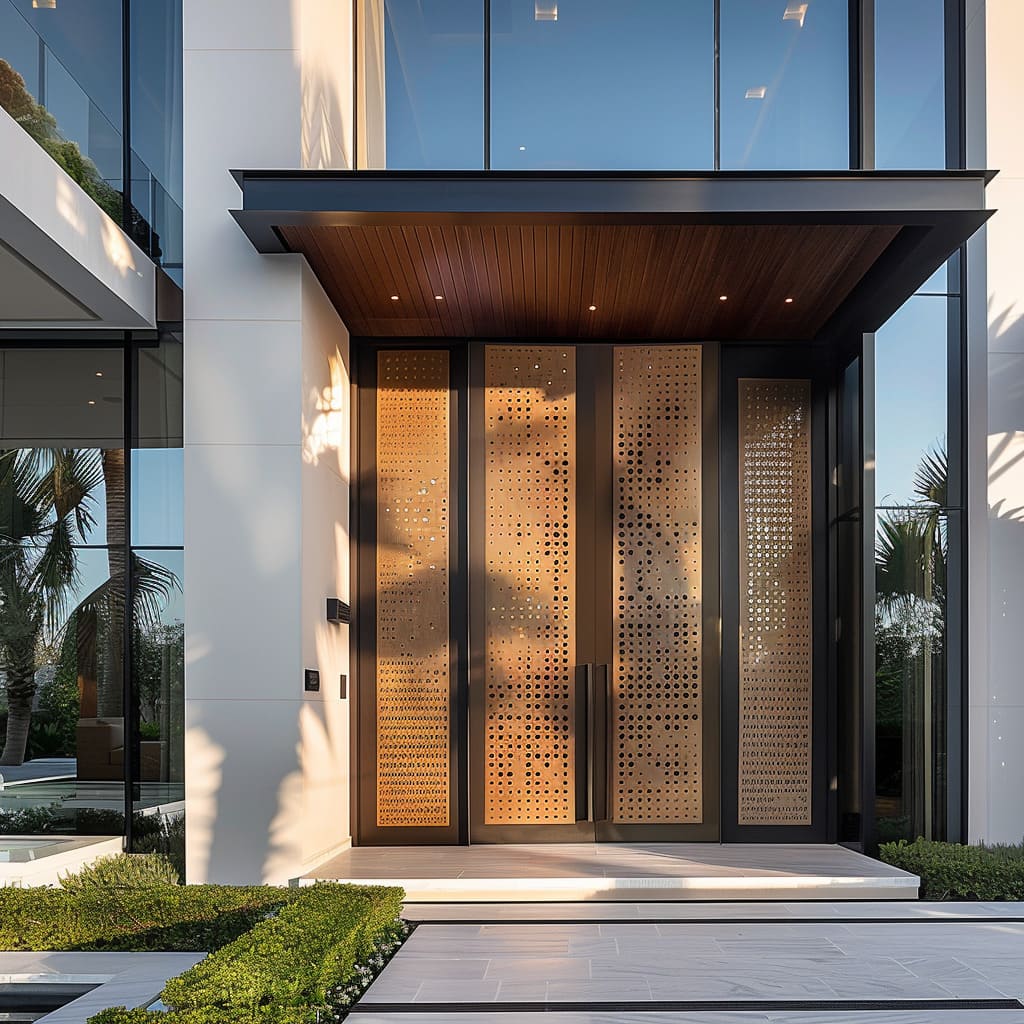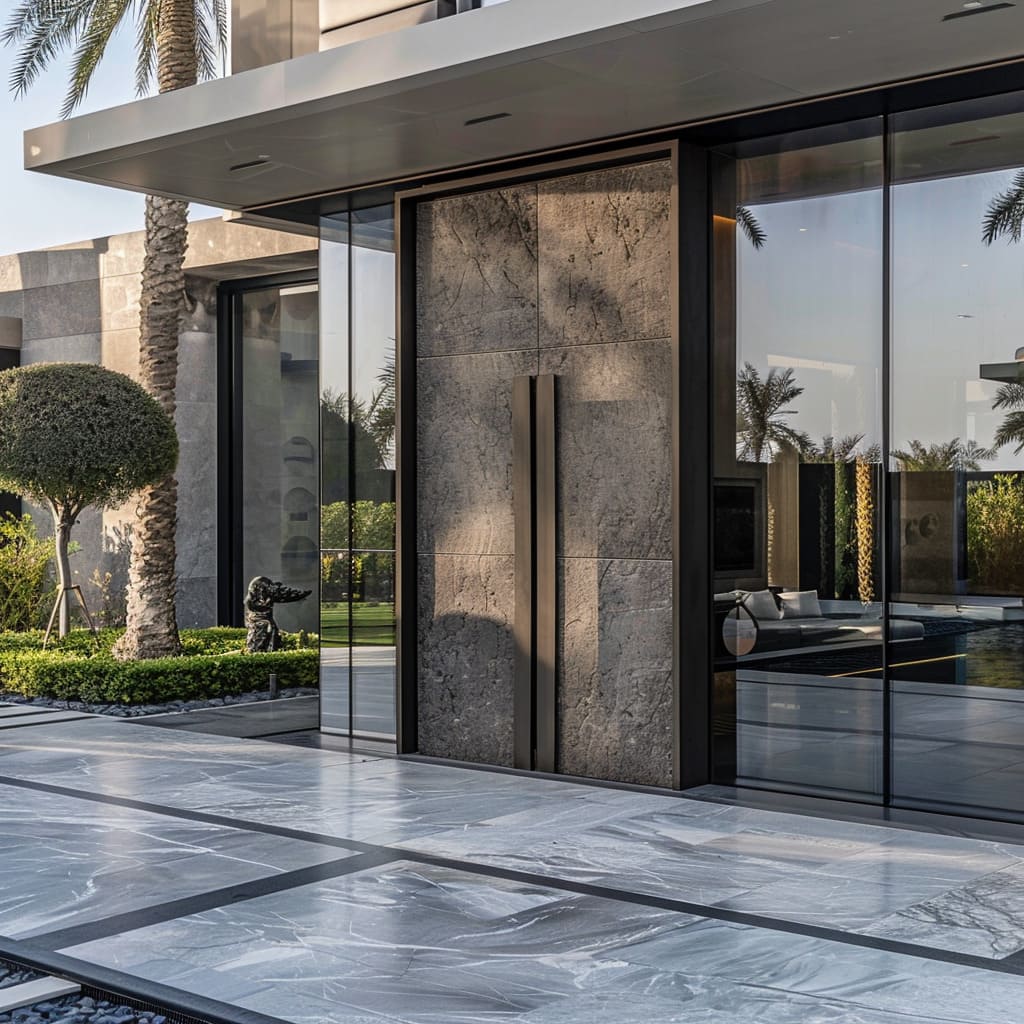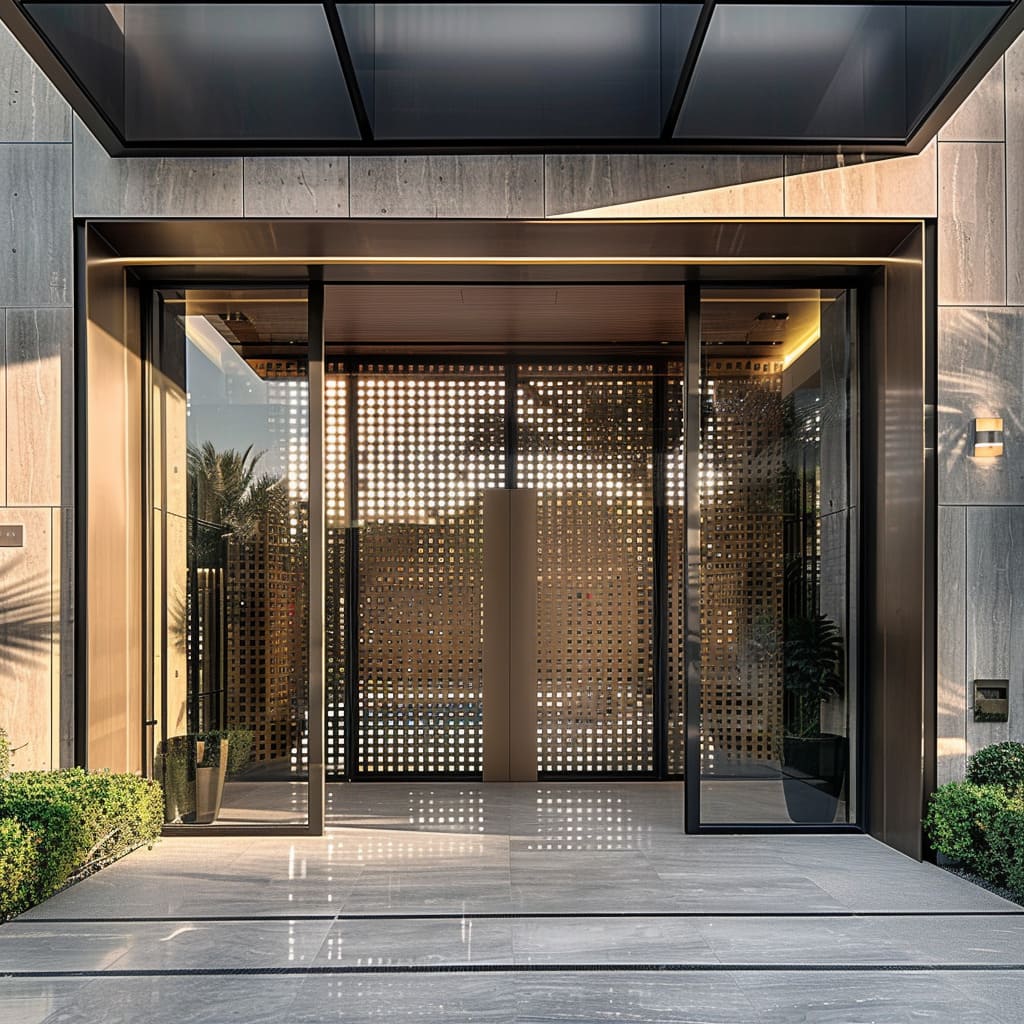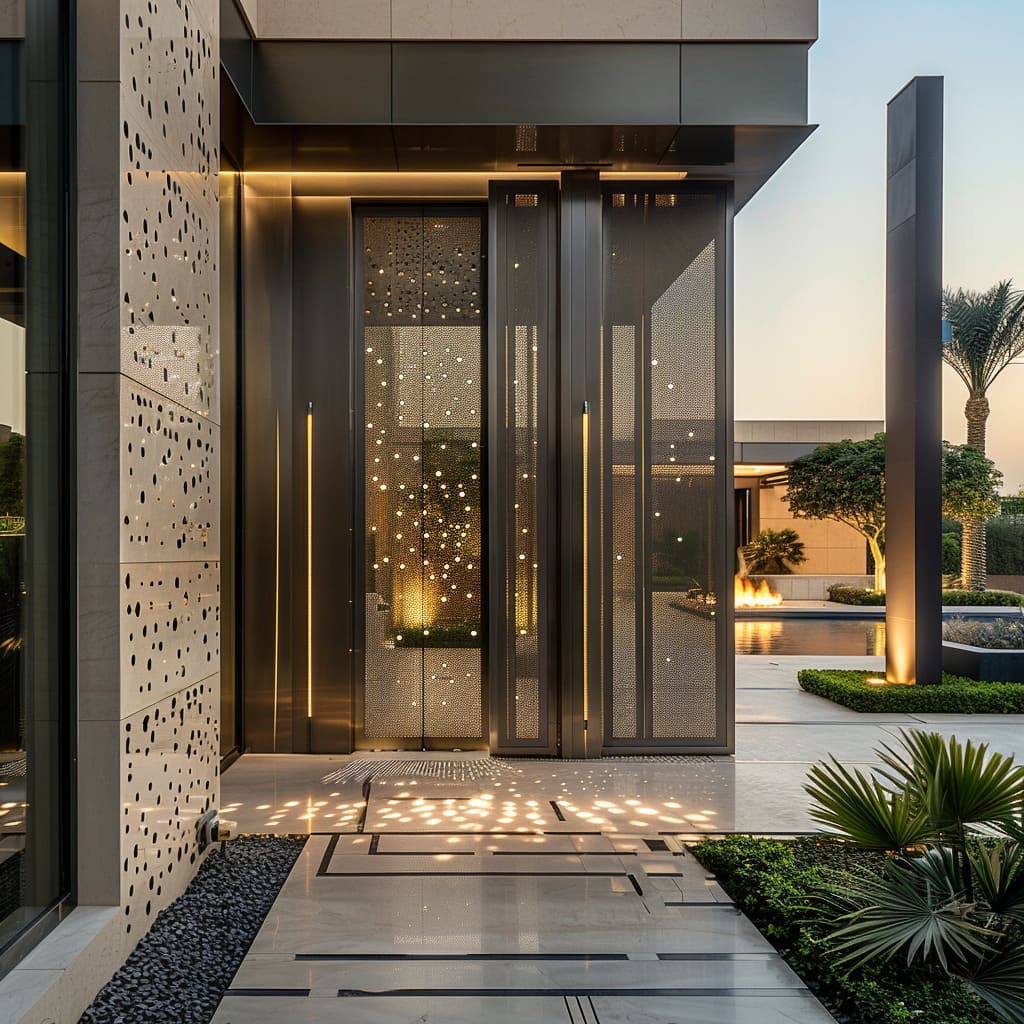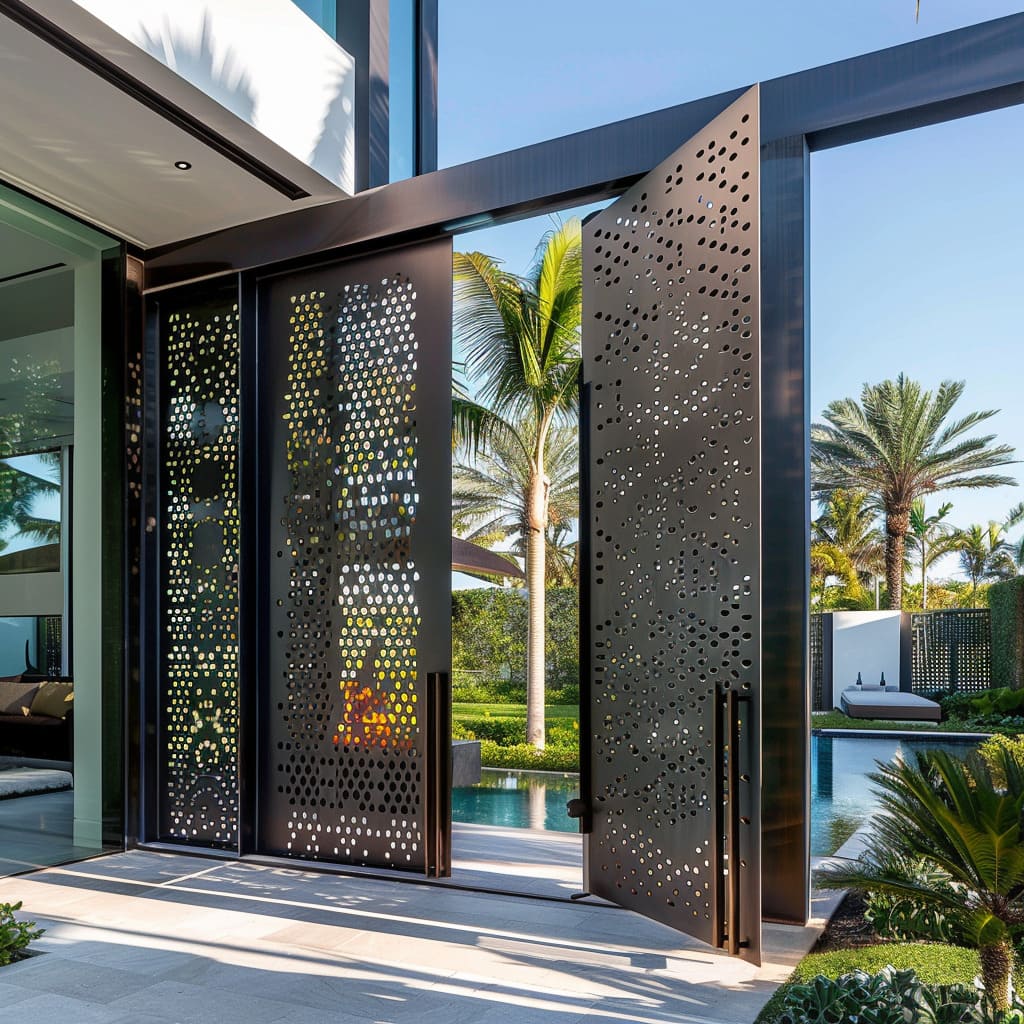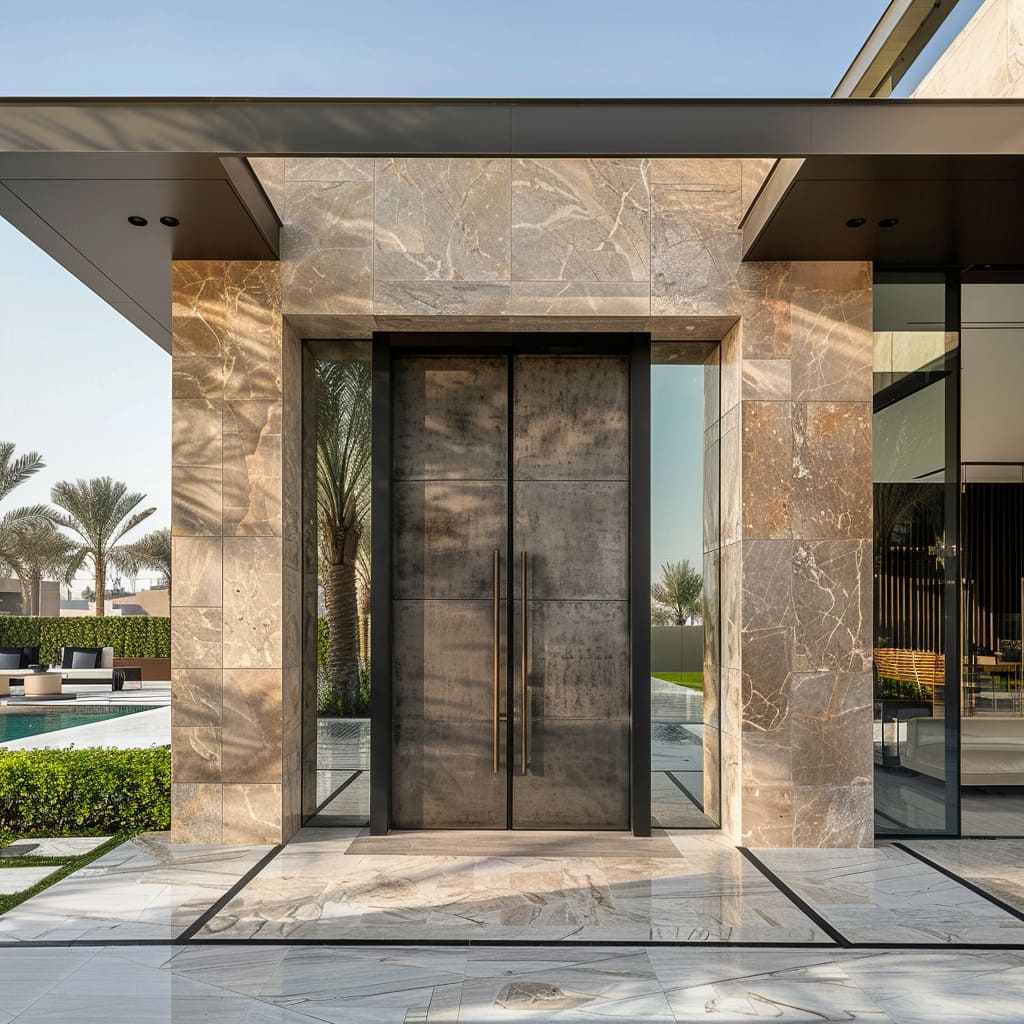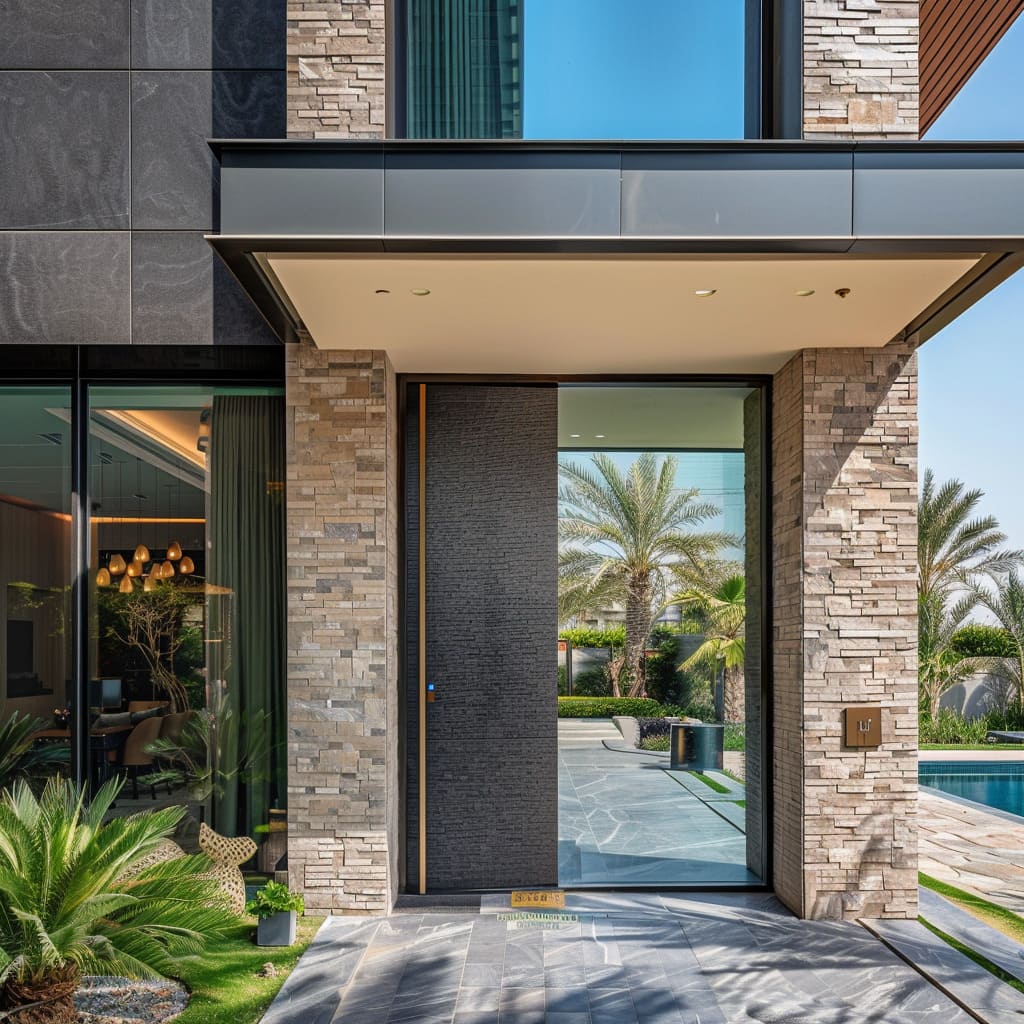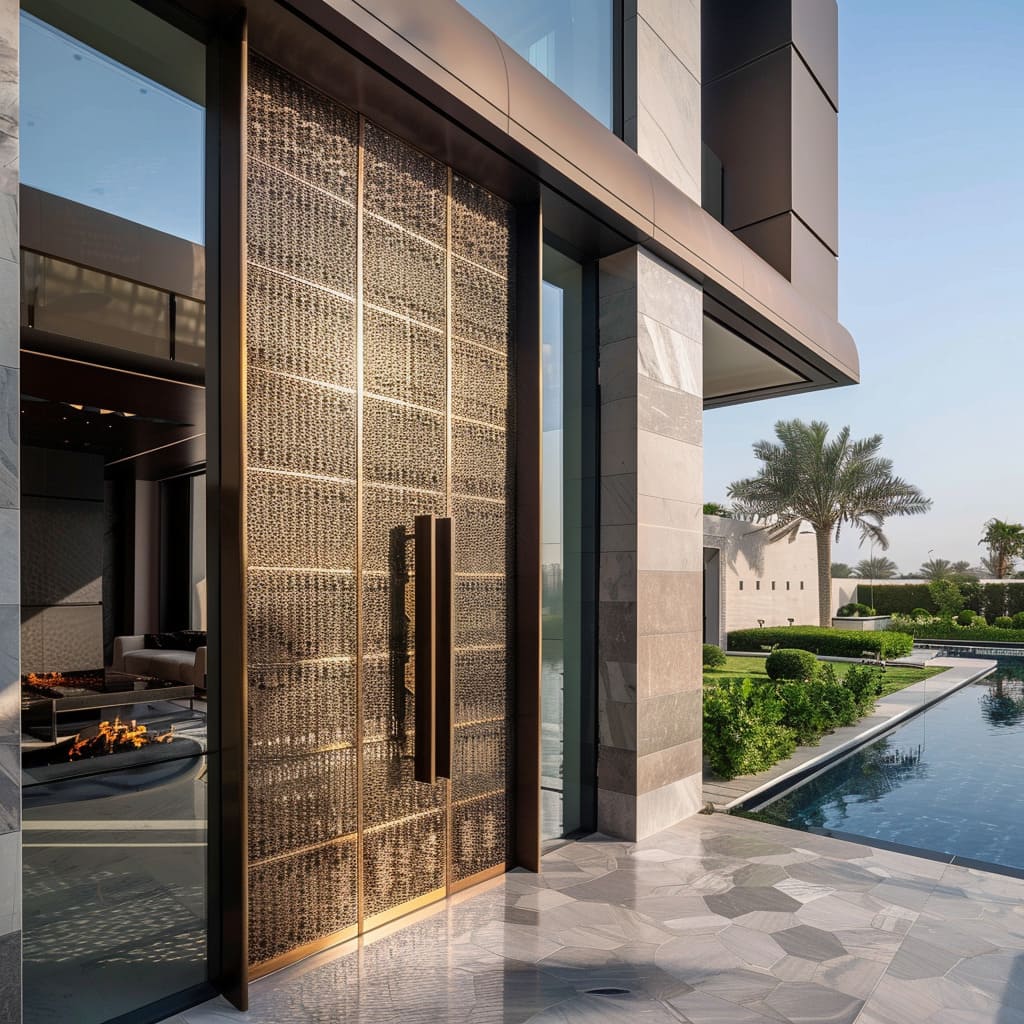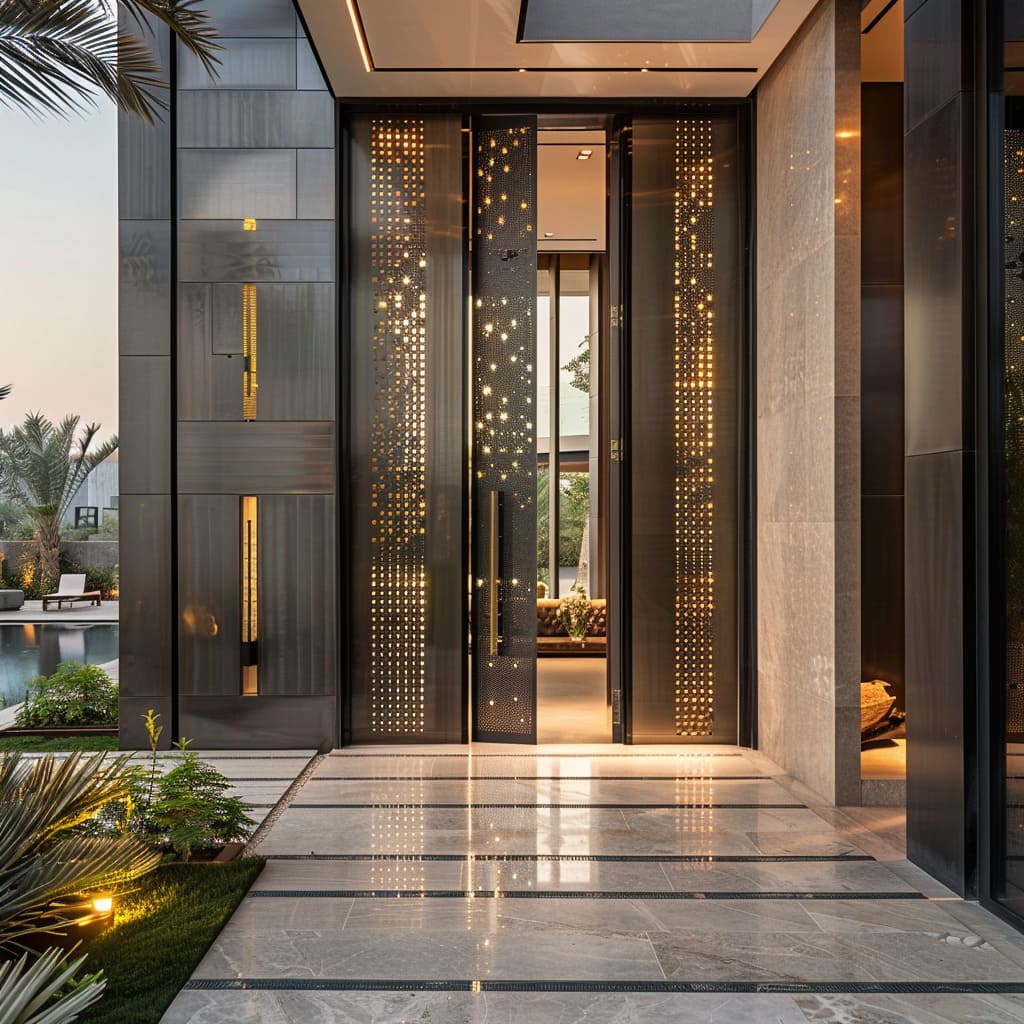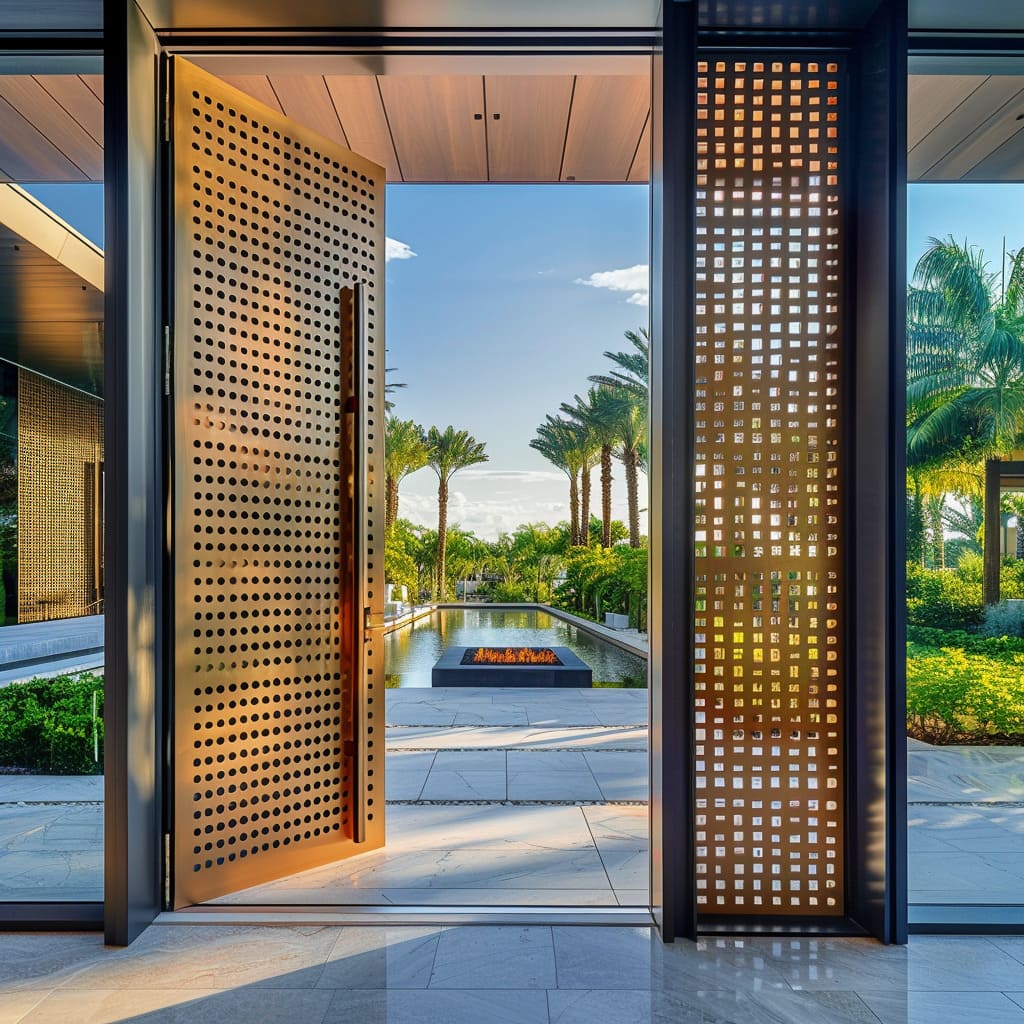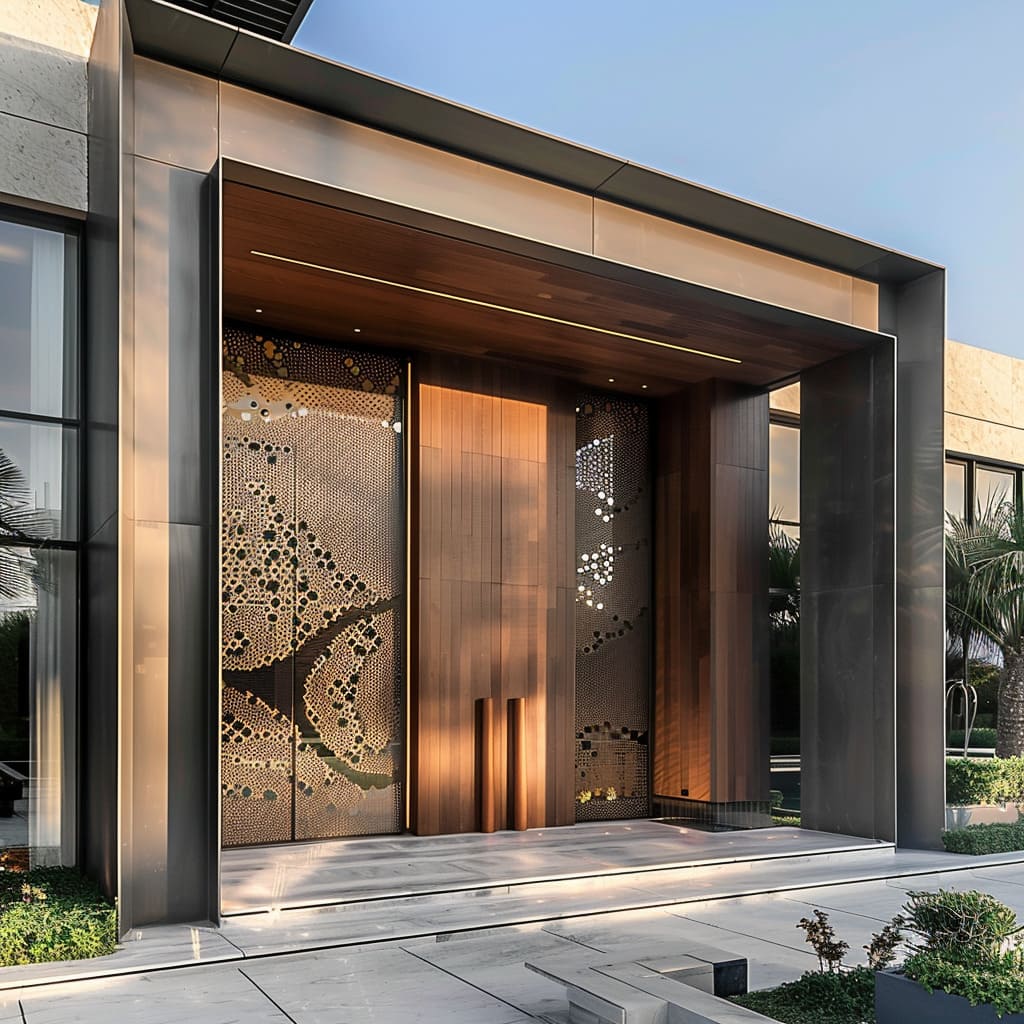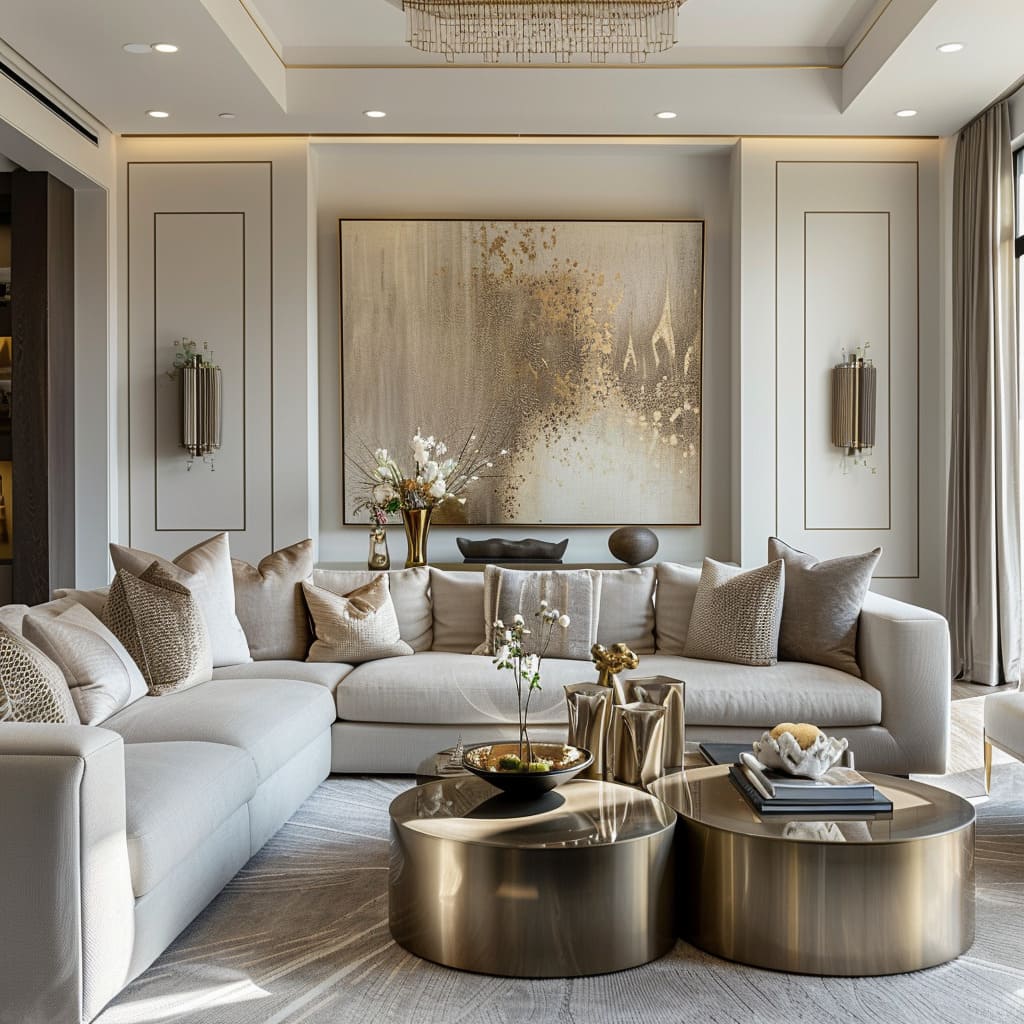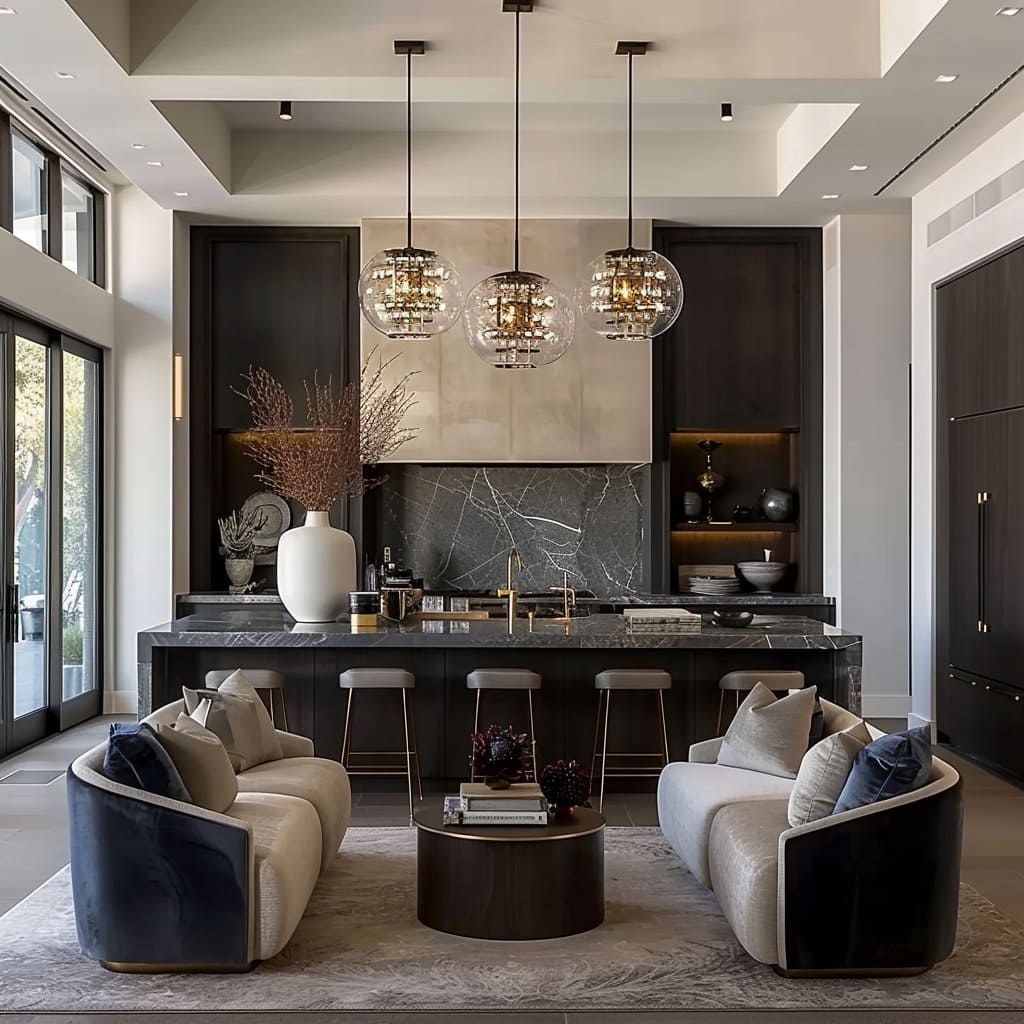In modern architecture, the main door of a house is more than just an entry point; it is a crucial element that sets the tone for the rest of the home. It often serves as the first impression, showcasing the homeowner’s style and the architectural narrative of the property.
As design trends evolve, the main door has emerged as a focal point, reflecting both functionality and aesthetic appeal. This article delves into the various aspects of modern main door designs, highlighting the latest trends, materials, patterns, and technological integrations that define contemporary entrances.
Material Choices in Modern Main Door Designs
High-Quality Wood
Wood has long been a preferred material for main doors, valued for its natural beauty, warmth, and durability. In modern designs, high-quality hardwoods such as walnut, mahogany, and teak are commonly used.
These woods are chosen not only for their strength and resilience but also for their rich, deep hues that can range from warm browns to darker, almost black shades. The grain of these woods adds texture and character to the door, making each one unique.
The choice of wood often comes with the consideration of how it will be finished. A natural finish highlights the wood’s innate patterns, while a stained finish can enhance or darken the tones to complement the exterior palette of the house.
Protective coatings are applied to ensure the wood remains resistant to weathering, UV rays, and pests. These treatments are crucial in maintaining the door’s appearance over time, ensuring that it can withstand the elements while still looking refined and polished.
Wooden doors also provide a sense of weight and presence, often making them the centerpiece of the entrance. They can be paired with other materials, such as glass or metal, to create a more layered and complex design.
This combination allows homeowners to blend traditional materials with modern aesthetics, offering a door that is both welcoming and contemporary.
Metal and Mixed Materials
In the realm of modern door design, metal has become a favored material, particularly for its durability, security, and ability to complement various architectural styles.
Metals such as stainless steel, aluminum, and bronze are commonly used, each offering distinct qualities. Stainless steel is known for its sleek, reflective surface that can make a door stand out, while aluminum provides a lighter, more malleable option that is still robust.
Bronze, on the other hand, brings a warmer, more classic appeal, often used in designs that seek a blend of modern and traditional elements.
The use of metal in door construction allows for innovative design possibilities. Metal doors can be entirely fabricated from these materials, or they can be combined with wood or glass to create a striking contrast.
For instance, a door might feature a metal frame with wooden panels or a combination of metal and frosted glass inserts. This interplay of materials adds depth and interest, making the door a statement piece.
Metal doors are often finished with treatments that prevent corrosion and enhance their longevity. Finishes can range from matte to brushed or even polished, depending on the desired aesthetic.
These finishes not only protect the door but also add to its overall appeal, making it a visually compelling part of the home’s exterior.
Glass Elements
Glass in main doors has become increasingly popular in modern designs, offering a way to incorporate light and transparency while maintaining privacy and security.
Glass panels can be integrated into the door itself or used alongside the door as sidelights or transoms. The type of glass chosen—whether clear, frosted, tinted, or textured—greatly influences the door’s appearance and functionality.
Clear glass provides maximum visibility and allows natural light to flood the entrance area, making it feel more open and connected to the outside. However, for those seeking privacy, frosted or textured glass is a preferred choice.
These types of glass obscure the view while still allowing light to pass through, creating a bright but private entryway. Tinted glass adds a layer of privacy and reduces glare, while still letting light through.
Incorporating glass into a door design also allows for creative expression through patterns, etching, or even colored glass. This can add an artistic element to the door, making it a unique feature of the home.
Additionally, glass can be combined with wood or metal to create a door that is not only functional but also an eye-catching centerpiece of the home’s exterior.
Design Patterns and Aesthetic Elements
Minimalist Design
Minimalism in main door design focuses on simplicity, clean lines, and the absence of excessive ornamentation. This design philosophy is rooted in the idea that less is more, where every element serves a purpose without unnecessary embellishments.
The minimalist approach often involves the use of a single, continuous material, such as wood or metal, that spans the entire door, creating a smooth and unbroken surface.
A key aspect of minimalist design is the attention to proportion and symmetry. Doors are designed to be perfectly aligned with the surrounding architectural elements, creating a sense of harmony and balance.
The lines are straight, and the forms are geometric, often with square or rectangular shapes dominating the design. This creates a door that is not only aesthetically pleasing but also exudes a sense of calm and order.
Minimalist doors often feature hidden or recessed handles, which contribute to the clean, uncluttered look. The hardware is usually concealed, and the focus is on the purity of the form and the quality of the materials used.
This approach results in a door that, while simple in appearance, is complex in its craftsmanship and attention to detail.
Perforated Patterns and Textures
Incorporating perforated patterns into door design is a trend that adds both visual interest and functional benefits. These patterns, often created by precise cutouts in metal or wood, can range from simple geometric shapes to more intricate designs that may be inspired by nature or cultural motifs.
The perforations allow light to pass through, creating a dynamic interplay of light and shadow on both sides of the door.
Perforated patterns serve multiple purposes. Aesthetically, they add texture and depth to the door, transforming a solid panel into a piece of art.
Functionally, they can provide ventilation and a sense of openness while still maintaining privacy. This makes them ideal for climates where airflow is important, or for designs that seek to blur the lines between indoor and outdoor spaces.
The use of perforated patterns also allows for customization. Homeowners can choose from a variety of patterns or even design their own, making the door a truly personal element of their home’s exterior.
These patterns can be combined with other materials, such as glass or fabric, to create a layered effect that adds even more dimension to the design.
Inset and Contrasting Materials
Adding insets or contrasting materials to a door design is another way to enhance its visual appeal. In modern designs, insets can be made from different materials like glass, metal, or even a different type of wood.
These insets are often placed vertically or horizontally, creating a break in the monotony of the door’s surface and adding a focal point.
The contrast between materials adds depth and interest. For example, a wooden door with a metal inset creates a striking juxtaposition of natural and industrial elements.
Similarly, a glass inset in a metal door introduces a sense of transparency and lightness to what might otherwise be a heavy, imposing structure. These contrasting elements are carefully chosen to complement each other, creating a cohesive design that is both functional and beautiful.
The use of insets also allows for practical considerations, such as incorporating windows for light or decorative panels that add a unique touch to the door.
Hardware and Technology Integration
Handle Design
The design of the door handle is a crucial element that can significantly impact the overall look and feel of the door. Modern designs often favor handles that are sleek, minimalist, and in line with the door’s overall aesthetic.
Vertical bar handles are popular, often extending across a significant portion of the door’s height, providing both a visual statement and practical functionality.
Recessed handles are another option, particularly in minimalist designs where the goal is to maintain a clean, uninterrupted surface. These handles are integrated into the door itself, creating a subtle and sophisticated look.
The material of the handle is usually chosen to complement the door, whether it’s the same material or a contrasting one, such as a metal handle on a wooden door.
Handles are not just about aesthetics; they also need to be ergonomic and easy to use. The placement and size of the handle are carefully considered to ensure comfort and ease of access.
In high-end designs, handles may also feature integrated lighting or touch-sensitive technology, adding an extra layer of modernity and convenience.
Advanced Locking Mechanisms
With the advancement of technology, the integration of smart locks and biometric systems into main door designs has become increasingly common.
These systems provide enhanced security and convenience, allowing homeowners to control access to their home with the touch of a button or a fingerprint. Smart locks can be controlled remotely via smartphone apps, enabling homeowners to lock or unlock their doors from anywhere.
Biometric systems, such as fingerprint or facial recognition, offer an additional level of security. These systems are designed to be both user-friendly and highly secure, making them a popular choice for modern homes.
The technology is often seamlessly integrated into the door’s design, with sensors and keypads either hidden or incorporated in a way that does not disrupt the door’s aesthetics.
In addition to these advanced systems, modern doors also feature robust mechanical locks and reinforced frames to ensure they are resistant to forced entry. This combination of traditional security features with cutting-edge technology provides a comprehensive solution that meets the demands of modern living.
Integration with Surrounding Architecture
Seamless Transition Between Indoor and Outdoor Spaces
A key trend in modern architecture is the seamless transition between indoor and outdoor spaces, and the main door plays a vital role in this integration. Large, floor-to-ceiling glass panels flanking the door allow for an unobstructed view of the outdoors, creating a connection between the home’s interior and its natural surroundings.
This design choice not only enhances the sense of space but also allows natural light to flood the entrance area, creating a bright and inviting atmosphere.
The door itself is often designed to complement this openness, with materials and finishes that echo the surrounding landscape. For example, a wooden door with glass insets might mirror the natural elements of the garden or outdoor area, creating a harmonious blend of indoor and outdoor aesthetics.
This integration is further enhanced by the use of similar materials and colors in the surrounding architectural elements, such as stone, metal, or wood cladding.
This approach to design not only creates a visually appealing entrance but also enhances the overall experience of entering the home. It creates a fluid transition that invites the outside in, making the home feel more connected to its environment.
Complementary Facade Materials
The materials used in the facade surrounding the main door are as important as the door itself. In modern designs, the facade often features a combination of materials that complement and enhance the door.
Stone cladding, metal panels, and wood are commonly used, each offering its own texture, color, and character.
Stone cladding adds a sense of solidity and permanence to the entrance, grounding the design and providing a natural contrast to the sleek surfaces of the door. The stones might be left in their natural state, with rough, uneven surfaces, or they could be honed and polished for a more refined look.
The color and texture of the stone are carefully chosen to complement the door’s materials, creating a cohesive and harmonious appearance.
Metal panels can add a modern, industrial edge to the facade, particularly when combined with glass or wood. The metal might be left in its raw state, with visible welds and seams, or it could be treated with a patina or paint to create a more polished look.
Wood, on the other hand, adds warmth and a natural element to the facade, softening the harder lines of the metal and stone.
The careful selection and combination of these materials create a facade that is both visually striking and complementary to the main door. It ensures that the entrance is not just a functional space but also a design statement that reflects the overall architectural style of the home.
Lighting and Ambiance
Lighting is a crucial element in modern main door design, influencing both the appearance and the atmosphere of the entrance. The use of recessed lighting in the ceiling above the entrance or along the sides of the door creates a soft, ambient glow, highlighting the materials and textures of the door and surrounding facade.
This lighting is often carefully positioned to emphasize the key features of the design, such as the door handle, the perforated patterns, or the contrast between different materials.
The type of lighting used can vary depending on the desired effect. Warm, soft lighting creates a welcoming and inviting ambiance, making the entrance feel more approachable.
Cooler lighting, on the other hand, can add a modern, almost futuristic edge to the design, particularly when combined with metal and glass elements.
Lighting is also used to enhance the safety and functionality of the entrance. Pathway lights, step lights, and motion sensors are often incorporated into the design, ensuring that the entrance is well-lit and accessible at all times.
This not only adds to the aesthetic appeal of the entrance but also provides practical benefits, making it easier and safer to navigate.
Trends in Modern Main Door Designs
Pivot Doors
Pivot doors have become a popular choice in modern architecture, known for their ability to support large, heavy panels while providing a smooth and effortless operation. Unlike traditional hinged doors, pivot doors rotate on a central or offset pivot point, allowing them to open and close with minimal resistance.
This makes them ideal for creating grand, dramatic entrances that make a strong visual statement.
The design of pivot doors often emphasizes the door’s size and weight, with large, solid panels that showcase the materials and craftsmanship. These doors are typically made from robust materials like wood, metal, or a combination of both, ensuring they are not only visually impressive but also durable and secure.
The pivot mechanism itself is usually concealed, maintaining the clean, uninterrupted lines that are characteristic of modern design.
Pivot doors also offer greater flexibility in terms of design, allowing for wider and taller doors that can make the entrance feel more open and inviting. They are often used in conjunction with large glass panels or sidelights, further enhancing the sense of space and connection to the outdoors.
This combination of form and function makes pivot doors a standout feature in contemporary homes.
Smart Design and Functionality
In the age of smart technology, the integration of advanced features into main door designs has become increasingly common. Homeowners are looking for doors that offer not only aesthetic appeal but also enhanced functionality and security.
This has led to the rise of smart locks, biometric access systems, and remote control features that allow homeowners to manage their door’s security from anywhere.
Smart locks can be operated via smartphone apps, enabling users to lock or unlock their doors remotely, grant temporary access to visitors, and monitor who enters and exits the home. These locks often feature keyless entry systems, such as touchpads or RFID readers, eliminating the need for traditional keys.
Biometric systems, which use fingerprints or facial recognition, provide an additional layer of security, ensuring that only authorized individuals can access the home.
These technological features are designed to be seamlessly integrated into the door’s design, often hidden or subtly incorporated to maintain the door’s aesthetic appeal. They offer convenience and peace of mind, making them a popular choice for modern homes where security and smart technology are a priority.
Organic and Geometric Patterns
Modern door designs are increasingly incorporating patterns that add visual interest and reflect the homeowner’s personal style. Organic patterns, inspired by nature, often feature flowing lines, abstract shapes, and asymmetrical designs that bring a sense of movement and life to the door.
These patterns can be created through the use of perforated metal screens, etched glass, or carved wood, adding texture and depth to the design.
Geometric patterns, on the other hand, are more structured and symmetrical, often featuring repeating shapes like squares, circles, or triangles. These patterns can be bold and eye-catching, making the door a focal point of the home’s exterior.
The use of geometric patterns is particularly popular in homes with a modern or minimalist aesthetic, where the clean lines and shapes complement the overall design.
Both organic and geometric patterns offer a way to personalize the main door, making it unique to the home. They can be used to reflect the architectural style of the property, create a connection to the surrounding environment, or simply add an artistic element to the design.
Conclusion
The design of a modern main door is a reflection of the homeowner’s style, the architectural theme of the house, and the latest trends in design and technology. By carefully selecting materials, incorporating thoughtful patterns, and integrating advanced hardware and technology, homeowners can create a door that is both functional and a striking feature of their home’s exterior.
Whether opting for a minimalist design, a pivot door, or a door with smart technology, the options are vast and varied, offering something for every taste and requirement. As trends continue to evolve, the main door remains a crucial element in defining the character and identity of modern homes.
Related Posts

Harmony Home Design brings 10+ years of residential interior design experience to the ideas shared here. Our designer often develops concepts that never end up in a client project; this blog is where we share those extra ideas, along with practical styling tips and design inspiration to spark fresh ideas for your own home.
